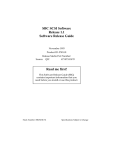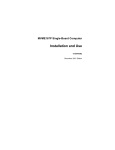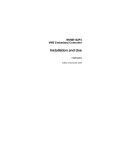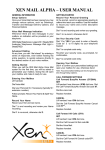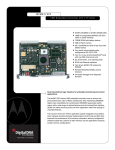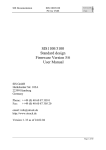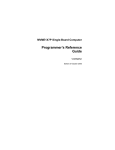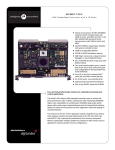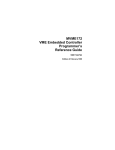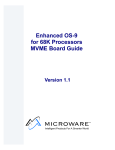Download MVME167 Single Board Computer User`s Manual
Transcript
MVME167
Single Board Computer
User’s Manual
Character User Interface:
Contents
CHAPTER 1
GENERAL INFORMATION
Introduction................................................................................................................1-1
Model Designations ...................................................................................................1-1
Features ......................................................................................................................1-2
Specifications .............................................................................................................1-3
Cooling Requirements ........................................................................................1-3
FCC Compliance.................................................................................................1-4
General Description ...................................................................................................1-5
Equipment Required ..................................................................................................1-6
Related Documentation..............................................................................................1-7
Support Information...................................................................................................1-8
Manual Terminology..................................................................................................1-9
CHAPTER 2
HARDWARE PREPARATION AND INSTALLATION
Introduction................................................................................................................2-1
Unpacking Instructions ..............................................................................................2-1
Hardware Preparation ................................................................................................2-1
General Purpose Readable Jumpers on Header J1..............................................2-2
System Controller Header J2 ..............................................................................2-2
Serial Port 4 Clock Configuration Select Headers J6 and J7..............................2-4
SRAM Backup Power Source Select Header J8.................................................2-5
Installation Instructions..............................................................................................2-6
MVME167 Module Installation..........................................................................2-6
System Considerations........................................................................................2-7
CHAPTER 3
OPERATING INSTRUCTIONS
Introduction................................................................................................................3-1
Controls and Indicators ..............................................................................................3-1
ABORT Switch S1..............................................................................................3-1
RESET Switch S2...............................................................................................3-1
Front Panel Indicators (DS1 - DS4)....................................................................3-2
Memory Maps ............................................................................................................3-3
Local Bus Memory Map .....................................................................................3-3
vii
Normal Address Range ............................................................................... 3-3
Detailed I/O Memory Maps ............................................................................3-6
BBRAM,TOD Clock Memory Map .............................................................3-26
Interrupt Acknowledge Map .........................................................................3-28
VMEbus Memory Map ........................................................................................3-29
VMEbus Accesses to the Local Bus .............................................................3-29
VMEbus Short I/O Memory Map .................................................................3-29
Software Initialization .................................................................................................3-30
Multi-MPU Programming Considerations ...........................................................3-30
Local Reset Operation ..........................................................................................3-30
CHAPTER 4
FUNCTIONAL DESCRIPTION
Introduction ...................................................................................................................4-1
MVME167 Functional Description ...............................................................................4-1
Data Bus Structure..................................................................................................4-1
MC68040 MPU ......................................................................................................4-2
EPROM ..................................................................................................................4-2
SRAM.....................................................................................................................4-2
Onboard DRAM .....................................................................................................4-3
Battery Backed Up RAM and Clock ......................................................................4-4
VMEbus Interface ..................................................................................................4-4
I/O Interfaces ..........................................................................................................4-5
Serial Port Interface.........................................................................................4-5
Parallel Port Interface......................................................................................4-6
Ethernet Interface ............................................................................................4-6
SCSI Interface .................................................................................................4-7
SCSI Termination............................................................................................4-7
Local Resources .....................................................................................................4-7
Programmable Tick Timers.............................................................................4-7
Watchdog Timer..............................................................................................4-8
Software-Programmable Hardware Interrupts ................................................4-8
Local Bus Timeout ..........................................................................................4-8
Timing Performance ...............................................................................................4-8
Local Bus to DRAM Cycle Times ..................................................................4-8
ROM Cycle Times ..........................................................................................4-9
SCSI Transfers ................................................................................................4-9
LAN DMA Transfers ......................................................................................4-9
Remote Status and Control...................................................................................4-10
viii
APPENDIX A
EIA-232-D INTERCONNECTIONS
Introduction.................................................................................................................. A-1
Levels of Implementation ............................................................................................ A-3
Signal Adaptations................................................................................................ A-3
Sample Configurations ......................................................................................... A-4
Proper Grounding ................................................................................................. A-6
ix
x
List of Figures
Figure 2-1. MVME167 Switches, Headers, Connectors, Fuses, and LEDs ..............2-3
Figure 4-1. MVME167 Main Module Block Diagram ............................................4-11
Figure 4-2. Parity DRAM Mezzanine Module Block Diagram...............................4-12
Figure 4-3. ECC DRAM Mezzanine Module Block Diagram ................................4-13
Figure A-1. Middle-of-the-Road EIA-232-D Configuration ....................................A-4
Figure A-2. Minimum EIA-232-D Connection ........................................................A-5
xi
xii
List of Tables
Table 1-1. MVME167 Model Designations...............................................................1-1
Table 1-2. MVME167 Specifications ........................................................................1-4
Table 3-1. Local Bus Memory Map ...........................................................................3-4
Table 3-2. Local I/O Devices Memory Map ..............................................................3-5
Table 3-3. VMEchip2 Memory Map (Sheet 1 of 3)...................................................3-8
Table 3-4. PCCchip2 Memory Map .........................................................................3-14
Table 3-5. Printer Memory Map ..............................................................................3-16
Table 3-6. MEMC040 Internal Register Memory Map ...........................................3-17
Table 3-7. MCECC Internal Register Memory Map................................................3-17
Table 3-8. Cirrus Logic CD2401 Serial Port Memory Map ....................................3-19
Table 3-9. 82596CA Ethernet LAN Memory Map ..................................................3-23
Table 3-10. 53C710 SCSI Memory Map .................................................................3-24
Table 3-11. MK48T08 BBRAM,TOD Clock Memory Map ...................................3-25
Table 3-12. BBRAM Configuration Area Memory Map.........................................3-25
Table 3-13. TOD Clock Memory Map.....................................................................3-26
Table A-1. EIA-232-D Interconnections...................................................................A-2
xiii
xiv
GENERAL INFORMATION
1
Introduction
This manual provides general information, preparation for use and installation
instructions, operating instructions, and functional description for the MVME167
series of Single Board Computers (referred to as the MVME167 throughout this
manual).
Model Designations
The MVME167 is available in several models, which are listed in Table 1-1.
MVME167 Model Designations on page 1-1.
Table 1-1. MVME167 Model Designations
Model Number
Speed
Major Differences
MVME167-001B (was MVME167-01 or -001A)
25 MHz
4MB Onboard Parity DRAM
MVME167-002B (was MVME167-02 or -002A)
25 MHz
8MB Onboard Parity DRAM
MVME167-003B (was MVME167-03 or -003A)
25 MHz
16MB Onboard Parity DRAM
MVME167-004B (was MVME167-04 or -004A)
25 MHz
32MB Onboard Parity DRAM
MVME167-031B (was MVME167-31 or -031A)
33 MHz
4MB Onboard ECC DRAM
MVME167-032B (was MVME167-32 or -032A)
33 MHz
8MB Onboard ECC DRAM
MVME167-033B (was MVME167-33 or -033A)
33 MHz
16MB Onboard ECC DRAM
MVME167-034B (was MVME167-34 or -034A)
33 MHz
32MB Onboard ECC DRAM
MVME167-035B (was MVME167-035A)
33 MHz
64MB Onboard ECC DRAM
MVME167-036B (was MVME167-036A)
33 MHz
128MB Onboard ECC DRAM
MVME167/D31-1
1
General Information
Features
Features of the MVME167 are listed below.
❏
MC68040 Microprocessor at 25 MHz (-00X models), or 33 MHz
(-03X models)
❏
4/8/16/32/64MB of 32-bit DRAM with parity protection
or 4/8/16/32/64/128/256MB of DRAM with ECC protection
❏
Four 44-pin PLCC ROM sockets (organized as two banks of 32 bits)
❏
128KB SRAM (with optional battery backup)
❏
Status LEDs for FAIL, STAT, RUN, SCON, LAN, +12V (LAN power), SCSI,
and VME.
❏
8K by 8 RAM and time of day clock with battery backup
❏
RESET and ABORT switches
❏
Four 32-bit tick timers for periodic interrupts
❏
Watchdog timer
❏
Eight software interrupts
❏
I/O
❏
1-2
–
SCSI Bus interface with DMA
–
Four serial ports with EIA-232-D buffers with DMA
–
Centronics printer port
–
Ethernet transceiver interface with DMA
VMEbus interface
–
VMEbus system controller functions
–
VMEbus interface to local bus (A24/A32,
D8/D16/D32 (D8/D16/D32/D64BLT) (BLT = Block Transfer)
–
Local bus to VMEbus interface (A16/A24/A32, D8/D16/D32)
–
VMEbus interrupter
–
VMEbus interrupt handler
–
Global CSR for interprocessor communications
–
DMA for fast local memory - VMEbus transfers (A16/A24/A32,
D16/D32 (D16/D32/D64BLT)
MVME167 Single Board Computer User’s Manual
Specifications
Specifications
General specifications for the MVME167 are listed in Table 1-2. MVME167
Specifications on page 1-4.
The following sections detail cooling requirements and FCC compliance.
Cooling Requirements
The Motorola MVME167 VMEmodule is specified, designed, and tested to operate
reliably with an incoming air temperature range from 0° to 55° C
(32° to 131° F) with forced air cooling at a velocity typically achievable by using a 100
CFM axial fan. Temperature qualification is performed in a standard Motorola
VMEsystem chassis. Twenty-five watt load boards are inserted in two card slots, one
on each side, adjacent to the board under test, to simulate a high power density system
configuration. An assembly of three axial fans, rated at 100 CFM per fan, is placed
directly under the VME card cage. The incoming air temperature is measured between
the fan assembly and the card cage, where the incoming airstream first encounters the
module under test. Test software is executed as the module is subjected to ambient
temperature variations. Case temperatures of critical, high power density integrated
circuits are monitored to ensure component vendors specifications are not exceeded.
While the exact amount of airflow required for cooling depends on the ambient air
temperature and the type, number, and location of boards and other heat sources,
adequate cooling can usually be achieved with 10 CFM and 490 LFM flowing over the
module. Less airflow is required to cool the module in environments having lower
maximum ambients. Under more favorable thermal conditions, it may be possible to
operate the module reliably at higher than 55° C with increased airflow. It is important
to note that there are several factors, in addition to the rated CFM of the air mover,
which determine the actual volume and speed of air flowing over a module.
MVME167/D3
1-3
1
1
General Information
Table 1-2. MVME167 Specifications
Characteristics
Specifications
Power requirements
(with all four EPROM
sockets populated and
excluding external
LAN transceiver)
+5 Vdc (± 5%), 3.5 A (typical), 4.5 A (max.)
(at 25 MHz, with 32MB parity DRAM);
5.0 A (typical), 6.5 A (max.)
(at 33 MHz, with 128MB ECC DRAM)
+12 Vdc (± 5%), 100 mA (max.)
(1.0 A (max.) with offboard LAN
transceiver)
-12 Vdc (± 5%), 100 mA (max.)
Operating temperature (refer to
Cooling Requirements section)
0° to 55° C at point of entry of forced air
(approximately 490 LFM)
Storage temperature
-40° to +85° C
Relative humidity
5% to 90% (non-condensing)
Physical dimensions
PC board with mezzanine
module
only
Height
Depth
Thickness
PC boards with connectors and front
panel
Height
Depth
Thickness
Double-high VMEboard
9.187 inches (233.35 mm)
6.299 inches (160.00 mm)
0.662 inches (16.77 mm)
10.309 inches (261.85 mm)
7.4 inches (188 mm)
0.80 inches (20.32 mm)
FCC Compliance
The MVME167 was tested in an FCC-compliant chassis, and meets the requirements
for Class A equipment. FCC compliance was achieved under the following conditions:
1-4
1.
Shielded cables on all external I/O ports.
2.
Cable shields connected to earth ground via metal shell connectors bonded to a
conductive module front panel.
3.
Conductive chassis rails connected to earth ground. This provides the path for
connecting shields to earth ground.
4.
Front panel screws properly tightened.
MVME167 Single Board Computer User’s Manual
General Description
For minimum RF emissions, it is essential that the conditions above be implemented;
failure to do so could compromise the FCC compliance of the equipment containing
the module.
General Description
The MVME167 is a double-high VMEmodule based on the MC68040 microprocessor.
The MVME167 has 4/8/16/32/64 MB of parity-protected DRAM or
4/8/16/32/64/128/256 MB of ECC-protected DRAM, 8KB of static RAM and time of
day clock (with battery backup), Ethernet transceiver interface, four serial ports with
EIA-232-D interface, four tick timers, watchdog timer, four ROM sockets, SCSI bus
interface with DMA, Centronics printer port, A16/A24/A32/D8/D16/D32/D64
VMEbus master/slave interface, 128KB of static RAM (with optional battery backup),
and VMEbus system controller.
The I/O on the MVME167 is connected to the VMEbus P2 connector. The main board
is connected through a P2 transition board and cables to the transition boards. The
MVME167 supports the transition boards MVME712-12, MVME712-13,
MVME712M, MVME712A, MVME712AM, and MVME712B (referred to in this
manual as MVME712X, unless separately specified). The MVME712X transition
boards provide configuration headers and provide industry standard connectors for the
I/O devices.
The VMEbus interface is provided by an ASIC called the VMEchip2. The VMEchip2
includes two tick timers, a watchdog timer, programmable map decoders for the master
and slave interfaces, and a VMEbus to/from local bus DMA controller, a VMEbus
to/from local bus non-DMA programmed access interface, a VMEbus interrupter, a
VMEbus system controller, a VMEbus interrupt handler, and a VMEbus requester.
Processor-to-VMEbus transfers can be D8, D16, or D32. VMEchip2 DMA transfers to
the VMEbus, however, can be D16, D32, D16/BLT, D32/BLT, or D64/MBLT.
The PCCchip2 ASIC provides two tick timers and the interface to the LAN chip, SCSI
chip, serial port chip, printer port, and BBRAM.
The MEMC040 memory controller ASIC provides the programmable interface for the
parity-protected DRAM mezzanine board.
The MCECC memory controller ASIC provides the programmable interface for the
ECC-protected DRAM mezzanine board.
MVME167/D3
1-5
1
1
General Information
Equipment Required
The following equipment is required to make a complete system using the MVME167:
❏
Terminal
❏
Disk drives and controllers
❏
Transition module MVME712-12, MVME712-13, MVME712M, MVME712A,
MVME712AM, or MVME712B, and connecting cables and P2 adapter
❏
Operating system
The MVME167Bug debug monitor firmware (167Bug) is provided in two of the four
EPROM sockets on the MVME167 main module. It provides over 50 debug,
up/downline load, and disk bootstrap load commands, as well as a full set of onboard
diagnostics and a one-line assembler/disassembler. 167Bug includes a user interface
which accepts commands from the system console terminal. 167Bug can also operate
in a System Mode, which includes choices from a service menu. Refer to the
MVME167Bug Debugging Package User’s Manual and the Debugging Package for
Motorola 68K CISC CPUs User’s Manual for details.
The MVME712X series of transition modules provide the interface between the
MVME167 module and peripheral devices. They connect the MVME167 to
EIA-232-D serial devices, Centronics-compatible parallel devices, SCSI devices, and
Ethernet devices. The MVME712X series work with cables and a P2 adapter.
Software available for the MVME167 includes SYSTEM V/68 and real-time operating
systems, programming languages, and other tools and applications. Contact your local
Motorola sales office for more details.
1-6
MVME167 Single Board Computer User’s Manual
Related Documentation
Related Documentation
The following publications are applicable to the MVME167 and may provide
additional helpful information. If not shipped with this product, they may be purchased
by contacting your local Motorola sales office. Non-Motorola documents may be
purchased from the sources listed.
Document Title
Motorola
Publication
Number
MVME167 Single Board Computer Support Information
(Refer to Support Information on page 1-8)
SIMVME167
MVME167Bug Debugging Package User’s Manual
MVME167BUG
Debugging Package for Motorola 68K CISC CPUs User’s Manual
68KBUG
Single Board Computers SCSI Software User’s Manual
SBCSCSI
MVME166/MVME167/MVME187 Single Board Computers
Programmer’s Reference Guide
MVME187PG
MVME712M Transition Module and P2 Adapter Board User’s
Manual
MVME712M
MVME712-12, MVME712-13, MVME712A, MVME712AM, and
MVME712B Transition Module and LCP2 Adapter Board User’s
Manual
MVME712A
M68040 Microprocessor User’s Manual
M68040UM
N ote
MVME167/D3
Although not shown in the above list, each Motorola Computer
Group manual publication number is suffixed with characters
which represent the revision level of the document, such as
"/D2" (the second revision of a manual); a supplement bears the
same number as a manual but has a suffix such as "/D2A1" (the
first supplement to the second edition of the manual).
1-7
1
1
General Information
The following publications are available from the sources indicated.
Versatile Backplane Bus: VMEbus, ANSI/IEEE Std 1014-1987, The Institute of
Electrical and Electronics Engineers, Inc., 345 East 47th Street, New York, NY 10017
(VMEbus Specification). This is also available as Microprocessor system bus for 1 to
4 byte data, IEC 821 BUS, Bureau Central de la Commission Electrotechnique
Internationale; 3, rue de Varembé, Geneva, Switzerland.
ANSI Small Computer System Interface-2 (SCSI-2), Draft Document X3.131-198X,
Revision 10c; Global Engineering Documents, P.O. Box 19539, Irvine, CA 92714.
CL-CD2400/2401 Four-Channel Multi-Protocol Communications Controller Data
Sheet, order number 542400-003; Cirrus Logic, Inc., 3100 West Warren Ave.,
Fremont, CA 94538.
82596CA Local Area Network Coprocessor Data Sheet, order number 290218; and
82596 User’s Manual, order number 296853; Intel Corporation, Literature Sales, P.O.
Box 58130, Santa Clara, CA 95052-8130.
NCR 53C710 SCSI I/O Processor Data Manual, order number NCR53C710DM; and
NCR 53C710 SCSI I/O Processor Programmer’s Guide, order number
NCR53C710PG; NCR Corporation, Microelectronics Products Division, Colorado
Springs, CO.
MK48T08(B) Timekeeper TM and 8Kx8 Zeropower TM RAM data sheet in Static
RAMs Databook, order number DBSRAM71; SGS-THOMPSON Microelectronics
Group; North & South American Marketing Headquarters, 1000 East Bell Road,
Phoenix, AZ 85022-2699.
Support Information
The SIMVME167 manual contains the connector interconnect signal information,
parts lists, and the schematics for the MVME167.
This manual may be obtained free of charge by contacting your local Motorola sales
office.
1-8
MVME167 Single Board Computer User’s Manual
Manual Terminology
Manual Terminology
Throughout this manual, a convention is used which precedes data and address
parameters by a character identifying the numeric format as follows:
$
dollar
specifies a hexadecimal character
%
percent
specifies a binary number
&
ampersand
specifies a decimal number
Unless otherwise specified, all address references are in hexadecimal.
An asterisk (*) following the signal name for signals which are level significant
denotes that the signal is true or valid when the signal is low.
An asterisk (*) following the signal name for signals which are edge significant
denotes that the actions initiated by that signal occur on high to low transition.
In this manual, assertion and negation are used to specify forcing a signal to a
particular state. In particular, assertion and assert refer to a signal that is active or true;
negation an negate indicate a signal that is inactive or false. These terms are used
independently of the voltage level (high or low) that they represent.
Data and address sizes are defined as follows:
❏
A byte is eight bits, numbered 0 through 7, with bit 0 being the least significant.
❏
A word is 16 bits, numbered 0 through 15, with bit 0 being the least significant.
❏
A longword is 32 bits, numbered 0 through 31, with bit 0 being the least
significant.
MVME167/D3
1-9
1
1
General Information
1-10
MVME167 Single Board Computer User’s Manual
HARDWARE PREPARATION
AND INSTALLATION
2
Introduction
This chapter provides unpacking instructions, hardware preparation, and installation
instructions for the MVME167. The MVME712X transition module hardware
preparation is provided in separate manuals. Refer to Related Documentation in
Chapter 1.
Unpacking Instructions
N ote
If the shipping carton is damaged upon receipt, request carrier’s
agent be present during unpacking and inspection of equipment.
Unpack equipment from shipping carton. Refer to packing list and verify that all items
are present. Save packing material for storing and reshipping of equipment.
C aution
Avoid touching areas of integrated circuitry; static discharge
can damage circuits.
Hardware Preparation
To select the desired configuration and ensure proper operation of the MVME167,
certain option modifications may be necessary before installation. The MVME167
provides software control for most of these options. Some options can not be done in
software, so are done by jumpers on headers. Most other modifications are done by
setting bits in control registers after the MVME167 has been installed in a system. (The
MVME167 registers are described in Chapter 4, and/or in the
MVME166/MVME167/MVME187 Single Board Computers Programmer’s Reference
Guide as listed in Related Documentation in Chapter 1.)
The location of the switches, jumper headers, connectors, and LED indicators on the
MVME167 is illustrated in Figure 2-1. The MVME167 has been factory tested and is
shipped with the factory jumper settings described in the following sections. The
MVME167 operates with its required and factory-installed Debug Monitor,
MVME167Bug (167Bug), with these factory jumper settings.
Settings can be made for:
❏
General purpose readable register (J1)
MVME167/D32-1
Hardware Preparation and Installation
2
❏
System controller select (J2)
❏
Serial port 4 clock configuration select (J6 and J7)
❏
SRAM backup power source select (J8) (optional)
General Purpose Readable Jumpers on Header J1
Each MVME167 may be configured with readable jumpers. These jumpers can be read
as a register (at $FFF40088) in the VMEchip2 LCSR. The bit values are read as a one
when the jumper is off, and as a zero when the jumper is on.
J1
2
16
1
15
GP10 GP11 GP12 GP13 GP14 GP15 GP16 GP17
All Zeros (Factory Configuration)
System Controller Header J2
The MVME167 can be VMEbus system controller. The system controller function is
enabled/disabled by jumpers on header J2. When the MVME167 is system controller,
the SCON LED is turned on. The VMEchip2 may be configured as a system controller
as follows.
J2
2
2
1
1
System Controller
(Factory Configuration)
2-2
J2
Not System Controller
MVME167 Single Board Computer User’s Manual
Hardware Preparation
2
MVME
167
1
39
40
2
6
A1
B1
C1
XU4
SKT
29
28
29
28
18
17
29
28
18
17
7
1
XU3
SKT
39
40
2
6
7
XU2
18
17
1
39
40
2
29
28
6
7
XU1
18
17
16
2
DS3
1
J2
SCSI VME
1
J1
DS2
P1
4
J8
3 2 1
(OPTIONAL)
19
20
J3
A32
B32
C32
1
2
F2
S1
S2
60
59
J4
A1
B1
C1
60
59
MEZZANINE BOARD
2
1
P2
J5
2
1
A32
B32
C32
J6
3
1
3
1
J7
1379 9404
2-3
MVME167/D3
PRIMARY SIDE
RESET
COMPONENTS ARE REMOVED FOR CLARITY
ABORT
15
LAN +12V
2
RUN SCON
2
7
DS1
39
40
6
1
FAIL HALT
DS4
Figure 2-1. MVME167 Switches, Headers, Connectors, Fuses, and LEDs
Hardware Preparation and Installation
2
Serial Port 4 Clock Configuration Select Headers J6 and J7
Serial port 4 can be configured to use clock signals provided by the RTXC4 and
TRXC4 signal lines. Headers J6 and J7 on the MVME167 configure serial port 4 to
drive or receive RTXC4 and TRXC4, respectively. Factory configuration is with port
4 set to receive both signals.
The remaining configuration of the clock lines is accomplished using the Serial Port 4
Clock Configuration Select header on the MVME712M transition module. Refer to the
MVME712M Transition Module and MVME147P2 Adapter Board User’s Manual for
configuration of that header
J6
J7
1
1
3
3
Receive RTXC4
Receive TRXC4
(Factory Configurations)
2-4
J6
J7
1
1
3
3
Drive RTXC4
Drive TRXC4
MVME167 Single Board Computer User’s Manual
Hardware Preparation
SRAM Backup Power Source Select Header J8
2
Header J8 is an optional header that is used to select the power source used to back up
the SRAM on the MVME167, if the optional battery and circuitry is present.
3
J8
J8
J8
4
4
4
2
1
Backup Power Disabled
C aution
MVME167/D3
3
2
1
VMEbus +5V STBY
(Factory Configuration, when
Optional Battery Is Present)
3
2
1
Optional Battery
Do not remove all jumpers from J8. This may disable the
SRAM.
If your board contains the optional header J8, but the optional
battery is removed, jumpers must be installed on J8 between
pins 2 and 4, as shown in the Backup Power Disabled drawing
above.
2-5
Hardware Preparation and Installation
2
Installation Instructions
The following sections discuss installation of the MVME167 into a VME chassis, and
system considerations. Ensure that EPROM devices are installed as needed. Factory
configuration is with two EPROMs installed for the MVME167Bug debug monitor, in
sockets XU1 and XU2. Ensure that all header jumpers are configured as desired.
MVME167 Module Installation
Now that the MVME167 module is ready for installation, proceed as follows:
1.
C aution
!
WARNING
2-6
Turn all equipment power OFF and disconnect power cable from ac power source.
Inserting or removing modules while power is applied could
result in damage to module components. WARNING
DANGEROUS VOLTAGES, CAPABLE OF CAUSING
DEATH, ARE PRESENT IN THIS EQUIPMENT. USE
EXTREME CAUTION WHEN HANDLING, TESTING, AND
ADJUSTING.
2.
Remove chassis cover as instructed in the equipment user’s manual.
3.
Remove the filler panel(s) from the appropriate card slot(s) at the front and rear of
the chassis (if the chassis has a rear card cage). The MVME167 module requires
power from both P1 and P2. It may be installed in any double-height unused card
slot, if it is not configured as system controller. If the MVME167 is configured as
system controller, it must be installed in the leftmost card slot (slot 1) to correctly
initiate the bus-grant daisy-chain and to have proper operation of the
IACK-daisy-chain driver. The MVME167 is to be installed in the front of the
chassis and the MVME712X is to be installed in the front or the rear of the chassis.
Other modules in the system may have to be moved to allow space for the
MVME712M which has a double-wide front panel.
4.
Carefully slide the MVME167 module into the card slot. Be sure the module is
seated properly into the P1 and P2 connectors on the backplane. Do not damage
or bend connector pins. Fasten the module in the chassis with screws provided,
making good contact with the transverse mounting rails to minimize RFI
emissions.
5.
Remove IACK and BG jumpers from the header on the chassis backplane for the
card slot the MVME167 is installed in.
MVME167 Single Board Computer User’s Manual
Installation Instructions
6.
Connect the P2 Adapter Board and specified cable(s) to the MVME167 at P2 on
the backplane at the MVME167 slot, to mate with (optional) terminals or other
peripherals at the EIA-232-D serial ports, parallel port, SCSI ports, and LAN
Ethernet port. Refer to the manuals listed in Related Documentation in Chapter 1
for information on installing the P2 Adapter Board and the MVME712X transition
module(s). (Some connection diagrams are in the
MVME166/MVME167/MVME187 Single Board Computers Programmer’s
Reference Guide.) Some cable(s) are not provided with the MVME712X
module(s), and therefore are made or provided by the user. (Motorola
recommends using shielded cables for all connections to peripherals to minimize
radiation.) Connect the peripherals to the cable(s). Detailed information on the
EIA-232-D signals supported is found in Appendix A.
7.
Install any other required VMEmodules in the system.
8.
Replace the chassis cover.
9.
Connect power cable to ac power source and turn equipment power ON.
System Considerations
The MVME167 needs to draw power from both P1 and P2 of the VMEbus backplane.
P2 is also used for the upper 16 bits of data for 32-bit transfers, and for the upper 8
address lines for extended addressing mode. The MVME167 may not operate properly
without its main board connected to P1 and P2 of the VMEbus backplane.
Whether the MVME167 operates as a VMEbus master or as a VMEbus slave, it is
configured for 32 bits of address and for 32 bits of data (A32/D32). However, it
handles A16 or A24 devices in the address ranges indicated in Chapter 3. D8 and/or
D16 devices in the system must be handled by the MC68040 software. Refer to the
memory maps in Chapter 3.
The MVME167 contains shared onboard DRAM whose base address is
software-selectable. Both the onboard processor and offboard VMEbus devices see
this local DRAM at base physical address $00000000, as programmed by the
MVME167Bug firmware. This may be changed, by software, to any other base
address. Refer to the MVME166/MVME167/MVME187 Single Board Computers
Programmer’s Reference Guide for details.
If the MVME167 tries to access offboard resources in a nonexistent location, and is not
system controller, and if the system does not have a global bus timeout, the MVME167
waits forever for the VMEbus cycle to complete. This would cause the system to hang
up. There is only one situation in which the system might lack this global bus timeout:
the MVME167 is not the system controller, and there is no global bus timeout
elsewhere in the system.
MVME167/D3
2-7
2
Hardware Preparation and Installation
Multiple MVME167 modules may be configured into a single VME card cage. In
general, hardware multiprocessor features are supported.
2
Other MPUs on the VMEbus can interrupt, disable, communicate with and determine
the operational status of the processor(s). One register of the GCSR set includes four
bits which function as location monitors to allow one MVME167 processor to
broadcast a signal to other MVME167 processors, if any. All eight registers are
accessible from any local processor as well as from the VMEbus.
The MVME167 provides +12 Vdc power to the Ethernet LAN transceiver interface
through a 1 amp fuse F2 located on the MVME167 module. The +12V LED lights
when +12 Vdc is available. The fuse is socketed, and located near diode CR1. If the
Ethernet transceiver fails to operate, check the fuse. When using the MVME712M
module, the yellow LED (DS1) on the MVME712M front panel lights when LAN
power is available, indicating that the fuse is good.
The MVME167 provides SCSI terminator power through a 1 amp fuse F1 located on
the P2 Adapter Board. The fuse is socketed. If the fuse is blown, the SCSI devices may
not operate or may function erratically. When the P2 Adapter Board is used with an
MVME712M and the SCSI bus is connected to the MVME712M, the green LED
(DS2) on the MVME712M front panel lights when there is SCSI terminator power. If
the LED flickers during SCSI bus operation, the fuse should be checked.
2-8
MVME167 Single Board Computer User’s Manual
OPERATING
INSTRUCTIONS
3
Introduction
This chapter provides necessary information to use the MVME167 module in a system
configuration. This includes controls and indicators, memory maps, and software
initialization of the module.
Controls and Indicators
The MVME167 module has ABORT and RESET switches; and FAIL, STAT, RUN,
SCON, LAN,+12V (LAN power), SCSI, and VME indicators; all located on the front
panel of the module.
ABORT Switch S1
When enabled by software, the front panel ABORT switch generates an interrupt at a
user-programmable level. It is normally used to abort program execution and return to
the 167Bug debugger firmware located in the MVME167 EPROMs.
The ABORT switch interrupter in the VMEchip2 is an edge-sensitive interrupter
connected to the ABORT switch. This interrupter is filtered to remove switch bounce.
RESET Switch S2
The front panel RESET switch resets all onboard devices, and drives SYSRESET* if
the board is system controller. The RESET switch may be disabled by software.
The VMEchip2 includes both a global and a local reset driver. When the chip operates
as the VMEbus system controller, the reset driver provides a global system reset by
asserting the VMEbus signal SYSRESET*. A SYSRESET* may be generated by the
RESET switch, a power up reset, a watchdog timeout, or by a control bit in the LCSR.
SYSRESET* remains asserted for at least 200 msec, as required by the VMEbus
specification.
Similarly, the VMEchip2 provides an input signal and a control bit to initiate a local
reset operation. By setting a control bit, software can maintain a board in a reset state,
disabling a faulty board from participating in normal system operation. The local reset
driver is enabled even when the VMEchip2 is not the system controller. A local reset
may be generated by the RESET switch, a power up reset, a watchdog timeout, a
VMEbus SYSRESET*, or a control bit in the GCSR.
Front Panel Indicators (DS1 - DS4)
There are eight LEDs on the MVME167 front panel: FAIL, STAT, RUN, SCON,
LAN, +12V (LAN power), SCSI, and VME.
MVME167/D33-1
Operating Instructions
❏
The red FAIL LED (part of DS1) lights when the BRDFAIL signal line is active.
❏
The MC68040 status lines are decoded, on the MVME167, to drive the yellow
STAT (status) LED (part of DS1). In this case, a halt condition from the processor
lights the LED.
❏
The green RUN LED (part of DS2) lights when the local bus TIP* signal line is
low. This indicates one of the local bus masters is executing a local bus cycle.
❏
The green SCON LED (part of DS2) lights when the VMEchip2 in the MVME167
is the VMEbus system controller.
❏
The green LAN LED (part of DS3) lights when the LAN chip is local bus master.
❏
The MVME167 supplies +12V power to the Ethernet transceiver interface
through a fuse. The green +12V (LAN power) LED (part of DS3) lights when
power is available to the transceiver interface.
❏
The green SCSI LED (part of DS4) lights when the SCSI chip is local bus master.
❏
The green VME LED (part of DS4) lights when the board is using the VMEbus
(VMEbus AS* is asserted by the VMEchip2) or when the board is accessed by the
VMEbus (VMEchip2 is the local bus master).
3
3-2
MVME167 Single Board Computer User’s Manual
Memory Maps
Memory Maps
There are two points of view for memory maps: 1) the mapping of all resources as
viewed by local bus masters (local bus memory map), and 2) the mapping of onboard
resources as viewed by VMEbus Masters (VMEbus memory map).
Local Bus Memory Map
The local bus memory map is split into different address spaces by the transfer type
(TT) signals. The local resources respond to the normal access and interrupt
acknowledge codes.
Normal Address Range
The memory map of devices that respond to the normal address range is shown in the
following tables. The normal address range is defined by the Transfer Type (TT)
signals on the local bus. On the MVME167, Transfer Types 0, 1, and 2 define the
normal address range.
Table 3-1. Local Bus Memory Map, is the entire map from $00000000 to $FFFFFFFF.
Many areas of the map are user-programmable, and suggested uses are shown in the
table. The cache inhibit function is programmable in the MMUs. The onboard I/O
space must be marked cache inhibit and serialized in its page table.
Table 3-2. Local I/O Devices Memory Map on page 3-5 further defines the map for the
local I/O devices.
MVME167/D3
3-3
3
Operating Instructions
Table 3-1. Local Bus Memory Map
3
Address Range
Devices Accessed
Port Size
Software
Cache
Inhibit
Size
Notes
$00000000 - DRAMSIZE
User Programmable
(Onboard DRAM)
D32
DRAMSIZE
N
1, 2
DRAMSIZE - $FF7FFFFF
User Programmable
D32/D16
3GB
?
3, 4
(VMEbus)
$FF800000 - $FFBFFFFF
ROM
D32
4MB
N
1
$FFC00000 - $FFDFFFFF
reserved
--
2MB
--
5
$FFE00000 - $FFE1FFFF
SRAM
D32
128KB
N
--
$FFE20000 - $FFEFFFFF
SRAM (repeated)
D32
896KB
N
--
$FFF00000 - $FFFEFFFF
Local I/O Devices
D32-D8
1MB
Y
3
D32/D16
64KB
?
2, 4
(Refer to next table)
$FFFF0000 - $FFFFFFFF
NOTES:
3-4
User Programmable
(VMEbus A16)
1. Onboard EPROM appears at $00000000 - $003FFFFF following a local bus
reset. The EPROM appears at 0 until the ROM0 bit is cleared in the VMEchip2.
The ROM0 bit is located at address $FFF40030 bit 20. The EPROM must be
disabled at 0 before the DRAM is enabled. The VMEchip2 and DRAM map
decoders are disabled by a local bus reset.
2. This area is user-programmable. The suggested use is shown in the table. The
DRAM decoder is programmed in the MEMC040 or MCECC chip, and the
local-to-VMEbus decoders are programmed in the VMEchip2.
3. Size is approximate.
4. Cache inhibit depends on devices in area mapped.
5. This area is not decoded. If these locations are accessed and the local bus timer
is enabled, the cycle times out and is terminated by a TEA signal.
MVME167 Single Board Computer User’s Manual
Memory Maps
The following table focuses on the Local I/O Devices portion of the local bus Main
Memory Map.9.
Table 3-2. Local I/O Devices Memory Map
Address Range
Devices Accessed
Port Size
Size
Notes
$FFF00000 - $FFF3FFFF
reserved
--
256KB
5
$FFF40000 - $FFF400FF
VMEchip2 (LCSR)
D32
256B
1,4
$FFF40100 - $FFF401FF
VMEchip2 (GCSR)
D32-D8
256B
1,4
$FFF40200 - $FFF40FFF
reserved
--
3.5KB
5,7
$FFF41000 - $FFF41FFF
reserved
$FFF42000 - $FFF42FFF
PCCchip2
$FFF43000 - $FFF430FF
$FFF43100 - $FFF431FF
--
4KB
5
D32-D8
4KB
1
MEMC040/MCECC #1
D8
256B
1
MEMC040/MCECC #2
D8
256B
1
$FFF43200 - $FFF43FFF
MEMC040s/MCECCs (repeated)
--
3.5KB
1,7
$FFF44000 - $FFF44FFF
reserved
--
4KB
5
$FFF45000 - $FFF451FF
CD2401 (Serial Comm. Cont.)
D16-D8
512B
1,9
$FFF45200 - $FFF45DFF
reserved
--
3KB
7,9
--
512B
1,9
D32
4KB
1,8
$FFF45E00 - $FFF45FFF
reserved
$FFF46000 - $FFF46FFF
82596CA (LAN)
$FFF47000 - $FFF47FFF
53C710 (SCSI)
$FFF48000 - $FFF4FFFF
reserved
D32/D8
4KB
1
--
32KB
5
$FFF50000 - $FFF6FFFF
reserved
--
128KB
5
$FFF70000 - $FFF76FFF
reserved
--
28KB
6
$FFF77000 - $FFF77FFF
reserved
--
4KB
2
$FFF78000 - $FFF7EFFF
reserved
--
28KB
6
$FFF7F000 - $FFF7FFFF
reserved
--
4KB
2
$FFF80000 - $FFF9FFFF
reserved
--
128KB
6
$FFFA0000 - $FFFBFFFF
reserved
$FFFC0000 - $FFFCFFFF
MK48T08 (BBRAM, TOD Clock)
-D32-D8
128KB
64KB
5
1
$FFFD0000 - $FFFDFFFF
reserved
--
64KB
5
$FFFE0000 - $FFFEFFFF
reserved
--
64KB
2
NOTES:
1. For a complete description of the register bits, refer to the data sheet for the
specific chip. For a more detailed memory map refer to the following detailed
peripheral device memory maps.
2. On the MVME167 this area does not return an acknowledge signal. If the local
bus timer is enabled, the access times out and is terminated by a TEA signal.
MVME167/D3
3-5
3
Operating Instructions
3. Byte reads should be used to read the interrupt vector. These locations do not
respond when an interrupt is not pending. If the local bus timer is enabled, the
access times out and is terminated by a TEA signal.
4. Writes to the LCSR in the VMEchip2 must be 32 bits. LCSR writes of 8 or 16
bits terminate with a TEA signal. Writes to the GCSR may be 8, 16 or 32 bits.
Reads to the LCSR and GCSR may be 8, 16 or 32 bits.
3
5. This area does not return an acknowledge signal. If the local bus timer is enabled,
the access times out and is terminated by a TEA signal.
6. This area does return an acknowledge signal.
7. Size is approximate.
8. Port commands to the 82596CA must be written as two 16-bit writes: upper word
first and lower word second.
9. The CD2401 appears repeatedly from $FFF45200 to $FFF45FFF on the
MVME167. If the local bus timer is enabled, the access times out and is
terminated by a TEA signal.
Detailed I/O Memory Maps
Tables 3-3 through 3-13 give the detailed memory maps for:
3-3
VMEchip2
3-9
82596CA Ethernet chip
3-4
PCCchip2
3-10 53C710 SCSI chip
3-5
Printer
3-11 MK48T08 BBRAM/TOD clock
3-6
MEMC040 memory controller chip
3-12 BBRAM configuration area
3-7
MCECC memory controller chip
3-13 TOD clock
3-8
CD2401 serial chip
Note: Manufacturers’ errata sheets for the various chips are available by contacting
your local Motorola sales representative. A non-disclosure agreement may be required.
3-6
MVME167 Single Board Computer User’s Manual
Memory Maps
3
This page intentionally left blank.
MVME167/D3
3-7
Operating Instructions
Table 3-3. VMEchip2 Memory Map (Sheet 1 of 3)
VMEchip2 LCSR Base Address = $FFF40000
OFFSET:
31
3
30
29
28
27
26
25
24
23
22
21
0
SLAVE ENDING ADDRESS 1
4
SLAVE ENDING ADDRESS 2
8
SLAVE ADDRESS TRANSLATION ADDRESS 1
C
19
18
17
16
SLAVE ADDRESS TRANSLATION ADDRESS 2
ADDER
2
10
31
30
29
28
27
SNP
2
26
25
WP
2
SUP
2
USR
2
A32
2
A24
2
BLK
D64
2
BLK
2
PRGM
2
DATA
2
24
23
22
21
20
19
18
17
16
14
MASTER ENDING ADDRESS 1
18
MASTER ENDING ADDRESS 2
1C
MASTER ENDING ADDRESS 3
20
MASTER ENDING ADDRESS 4
MASTER ADDRESS TRANSLATION ADDRESS 4
24
28
20
MAST
D16
EN
MAST
WP
EN
MAST
D16
EN
MASTER AM 4
31
30
29
28
27
26
MASTER AM 3
GCSR
BOARD SELECT
GCSR GROUP SELECT
2C
MAST
WP
EN
25
30
24
23
22
21
20
WAIT
RMW
ROM
ZERO
MAST
4
EN
MAST
3
EN
MAST
2
EN
MAST
1
EN
19
18
17
16
DMA TB
SNP MODE
SRAM
SPEED
34
38
DMA CONTROLLER
3C
DMA CONTROLLER
40
DMA CONTROLLER
44
48
DMA CONTROLLER
TICK
2/1
TICK
IRQ 1
EN
CLR
IRQ
IRQ
STAT
VMEBUS
INTERRUPT
LEVEL
VMEBUS INTERRUPT VECTOR
This sheet continues on facing page.
3-8
MVME167 Single Board Computer User’s Manual
Memory Maps
15
14
13
12
11
10
9
8
7
6
5
4
3
2
1
0
3
SLAVE STARTING ADDRESS 1
SLAVE STARTING ADDRESS 2
SLAVE ADDRESS TRANSLATION SELECT 1
SLAVE ADDRESS TRANSLATION SELECT 2
ADDER
1
15
14
13
12
SNP
1
11
10
9
WP
1
SUP
1
USR
1
8
7
6
A32
1
A24
1
BLK
D64
1
BLK
1
PRGM
1
DATA
1
4
3
2
1
0
5
MASTER STARTING ADDRESS 1
MASTER STARTING ADDRESS 2
MASTER STARTING ADDRESS 3
MASTER STARTING ADDRESS 4
MASTER ADDRESS TRANSLATION SELECT 4
MAST
D16
EN
MAST
WP
EN
IO2
EN
IO2
WP
EN
15
14
ARB
ROBN
MAST
DHB
DMA
TBL
INT
MAST
D16
EN
MASTER AM 2
IO2
S/U
13
MAST
DWB
DMA LB
SNP MODE
IO2
P/D
12
IO1
EN
IO1
D16
EN
IO1
WP
EN
IO1
S/U
9
8
11
10
MST
FAIR
MST
RWD
DMA
INC
VME
DMA
INC
LB
DMA
WRT
MPU
LBE
ERR
MPU
LPE
ERR
MAST
WP
EN
MASTER AM 1
ROM
SIZE
ROM BANK B
SPEED
7
6
DMA
HALT
DMA
EN
DMA
TBL
DMA
FAIR
DMA
D16
DMA
D64
BLK
DMA
BLK
DMA
AM
5
DMA
AM
4
DMA
AM
3
DMA
AM
2
DMA
AM
1
DMA
AM
0
MPU
LOB
ERR
MPU
LTO
ERR
DMA
LBE
ERR
DMA
LPE
ERR
DMA
LOB
ERR
DMA
LTO
ERR
DMA
TBL
ERR
DMA
VME
ERR
DMA
DONE
MASTER
VMEBUS
5
4
ROM BANK A
SPEED
3
2
DM
RELM
1
0
DMA
VMEBUS
LOCAL BUS ADDRESS COUNTER
VMEBUS ADDRESS COUNTER
BYTE COUNTER
TABLE ADDRESS COUNTER
DMA TABLE
INTERRUPT COUNT
MPU
CLR
STAT
1360 9403
This sheet begins on facing page.
MVME167/D3
3-9
Operating Instructions
Table 3-3. VMEchip2 Memory Map (Sheet 2 of 3)
3
VMEchip2 LCSR Base Address = $FFF40000
OFFSET:
31
30
29
28
27
26
25
24
23
22
ARB
BGTO
EN
4C
21
20
DMA
TIME OFF
19
18
17
16
VME
GLOBAL
TIMER
DMA
TIME ON
50
TICK TIMER 1
54
TICK TIMER 1
58
TICK TIMER 2
TICK TIMER 2
5C
SCON
60
SYS
FAIL
BRD
FAIL
STAT
PURS
STAT
CLR
PURS
STAT
BRD
FAIL
OUT
RST
SW
EN
SYS
RST
WD
CLR
TO
WD
CLR
CNT
WD
TO
STAT
TO
BF
EN
WD
SRST
LRST
WD
RST
EN
64
WD
EN
PRE
31
30
29
28
27
26
25
24
23
22
21
20
19
18
17
16
68
AC
FAIL
IRQ
AB
IRQ
SYS
FAIL
IRQ
MWP
BERR
IRQ
PE
IRQ
IRQ1E
IRQ
TIC2
IRQ
TIC1
IRQ
VME
IACK
IRQ
DMA
IRQ
SIG3
IRQ
SIG2
IRQ
SIG1
IRQ
SIG0
IRQ
LM1
IRQ
LM0
IRQ
6C
EN
IRQ
31
EN
IRQ
30
EN
IRQ
29
EN
IRQ
28
EN
IRQ
27
EN
IRQ
26
EN
IRQ
25
EN
IRQ
24
EN
IRQ
23
EN
IRQ
22
EN
IRQ
21
EN
IRQ
20
EN
IRQ
19
EN
IRQ
18
EN
IRQ
17
EN
IRQ
16
CLR
IRQ
31
CLR
IRQ
30
CLR
IRQ
29
CLR
IRQ
28
CLR
IRQ
27
CLR
IRQ
26
CLR
IRQ
25
CLR
IRQ
24
CLR
IRQ
23
CLR
IRQ
22
CLR
IRQ
21
CLR
IRQ
20
CLR
IRQ
19
CLR
IRQ
18
CLR
IRQ
17
CLR
IRQ
16
70
74
78
AC FAIL
IRQ LEVEL
ABORT
IRQ LEVEL
SYS FAIL
IRQ LEVEL
MST WP ERROR
IRQ LEVEL
7C
VME IACK
IRQ LEVEL
DMA
IRQ LEVEL
SIG 3
IRQ LEVEL
SIG 2
IRQ LEVEL
80
SW7
IRQ LEVEL
SW6
IRQ LEVEL
SW5
IRQ LEVEL
SW4
IRQ LEVEL
84
SPARE
IRQ LEVEL
VME IRQ 7
IRQ LEVEL
VME IRQ 6
IRQ LEVEL
VME IRQ 5
IRQ LEVEL
88
VECTOR BASE
REGISTER 0
VECTOR BASE
REGISTER 1
MST
IRQ
EN
SYS
FAIL
LEVEL
AC
FAIL
LEVEL
ABORT
GPIOEN
LEVEL
8C
This sheet continues on facing page.
3-10
MVME167 Single Board Computer User’s Manual
Memory Maps
3
15
14
13
VME
ACCESS
TIMER
12
11
LOCAL
BUS
TIMER
10
9
8
7
6
5
WD
TIME OUT
SELECT
4
3
2
1
0
CLR
OVF
1
COC
EN
1
TIC
EN
1
PRESCALER
CLOCK ADJUST
COMPARE REGISTER
COUNTER
COPARE REGISTER
COUNTER
CLR
OVF
2
OVERFLOW
COUNTER 2
COC
EN
2
TIC
EN
2
OVERFLOW
COUNTER 1
SCALER
15
14
13
12
11
10
9
8
7
6
5
4
3
2
1
0
SW7
IRQ
SW6
IRQ
SW5
IRQ
SW4
IRQ
SW3
IRQ
SW2
IRQ
SW1
IRQ
SW0
IRQ
SPARE
VME
IRQ7
VME
IRQ6
VME
IRQ5
VME
IRQ4
VME
IRQ3
VME
IRQ2
VME
IRQ1
EN
IRQ
15
EN
IRQ
14
EN
IRQ
13
EN
IRQ
12
EN
IRQ
11
EN
IRQ
10
EN
IRQ
9
EN
IRQ
8
EN
IRQ
7
EN
IRQ
6
EN
IRQ
5
EN
IRQ
4
EN
IRQ
3
EN
IRQ
2
EN
IRQ
1
EN
IRQ
0
SET
IRQ
15
SET
IRQ
14
SET
IRQ
13
SET
IRQ
12
SET
IRQ
11
SET
IRQ
10
SET
IRQ
9
SET
IRQ
8
CLR
IRQ
15
CLR
IRQ
14
CLR
IRQ
13
CLR
IRQ
12
CLR
IRQ
11
CLR
IRQ
10
CLR
IRQ
9
CLR
IRQ
8
P ERROR
IRQ LEVEL
IRQ1E
IRQ LEVEL
TIC TIMER 2
IRQ LEVEL
TIC TIMER 1
IRQ LEVEL
SIG 1
IRQ LEVEL
SIG 0
IRQ LEVEL
LM 1
IRQ LEVEL
LM 0
IRQ LEVEL
SW3
IRQ LEVEL
SW2
IRQ LEVEL
SW1
IRQ LEVEL
SW0
IRQ LEVEL
VME IRQ 4
IRQ LEVEL
VMEB IRQ 3
IRQ LEVEL
VME IRQ 2
IRQ LEVEL
VME IRQ 1
IRQ LEVEL
GPIOO
GPIOI
GPI
MP
IRQ
EN
REV
EROM
DIS
SRAM
DIS
MST
NO
EL
BBSY
DIS
BSYT
EN
INT
DIS
BGN
1361 9403
This sheet begins on facing page.
MVME167/D3
3-11
Operating Instructions
3
This page intentionally left blank.
3-12
MVME167 Single Board Computer User’s Manual
Memory Maps
Table 3-3. VMEchip2 Memory Map (Sheet 3 of 3)
VMEchip2 GCSR Base Address = $FFF40100
3
Offsets
VME- Local
bus Bus
0
0
2
4
15
14
13
LM3
LM2
LM1
12
11
10
9
8
7
6
5
SIG2
SIG1
SIG0
RST
ISF
BF
CHIP REVISION
LM0
SIG3
4
2
1
0
X
X
X
CHIP ID
SCON SYSFL
4
8
GENERAL PURPOSE CONTROL AND STATUS REGISTER 0
6
C
GENERAL PURPOSE CONTROL AND STATUS REGISTER 1
8
10
GENERAL PURPOSE CONTROL AND STATUS REGISTER 2
A
14
GENERAL PURPOSE CONTROL AND STATUS REGISTER 3
C
18
GENERAL PURPOSE CONTROL AND STATUS REGISTER 4
E
1C
GENERAL PURPOSE CONTROL AND STATUS REGISTER 5
MVME167/D3
3
3-13
Operating Instructions
Table 3-4. PCCchip2 Memory Map
3
PCCchip2 Base Address = $FFF42000
OFFSET:
D31
D24
D23
D16
CHIP ID
00
CHIP REVISION
04
TIC TIMER 1
08
TIC TIMER 1
0C
TIC TIMER 2
10
TIC TIMER 2
14
PRESCALER COUNT REGISTER
GPI
IEN
GPI
ICLR
SCC
RTRY
ERR
SCC
PAR
ERR
SCC
EXT
ERR
SCC
LTO
ERR
SCC
SCLR
28
LAN
PAR
ERR
LAN
EXT
ERR
LAN
LTO
ERR
LAN
SCLR
2C
SCSI
PAR
ERR
SCSI
EXT
ERR
SCSI
LTO
ERR
SCSI
SCLR
18
GPI
PLTY
GPI
E/L*
GPI
INT
PRESCALER CLOCK ADJUST
1C
GPI
IRQ LEVEL
GPI
SCC
MDM
ERR
SCC
MDM
IEN
SCC
MDM
AVEC
GPOE
GPO
SCC MODEM
IRQ LEVEL
20
24
30
34
SCC TRANSMIT PIACK
PRTR
ACK
PLTY
PRTR
BSY
PLTY
PRTR
ACK
E/L*
PRTR
BSY
E/L*
PRTR
ACK
INT
PRTR
BSY
INT
PRTR
ACK
IEN
PRTR
BSY
IEN
PRTR
ACK
ICLR
PRTR
BSY
ICLR
38
PRTR ACK
IRQ LEVEL
PRTR
FLT
PLTY
PRTR
FLT
E/L*
PRTR
FLT
INT
PRTR
FLT
IEN
PRTR
FLT
ICLR
PRTR FAULT
IRQ LEVEL
PRTR BSY
IRQ LEVEL
CHIP SPEED
3C
SCC PROVIDES ITS OWN VECTORS
This sheet continues on facing page.
3-14
MVME167 Single Board Computer User’s Manual
Memory Maps
3
D15
D8
DRO
CPU
040
MSTR
INT
EN
FAST
BRAM
CLR
OVF
2
COC
EN
2
TIC
EN
2
D7
D0
VECTOR BASE REGISTER
COMPARE REGISTER
COUNTER REGISTER
COMPARE REGISTER
COUNTER REGISTER
OVERFLOW
COUNTER 2
TIC2
INT
TIC2
IEN
TIC2
ICLR
TIC TIMER 2
IRQ LEVEL
SCC
TX
IRQ
SCC
TX
IEN
SCC
TX
AVEC
SCC TRANSMIT
IRQ LEVEL
CLR
OVF
1
OVERFLOW
COUNTER 1
SCC
SC1
SCC
SC0
COC
EN
1
TIC
EN
1
TIC1
INT
TIC1
IEN
TIC1
ICLR
TIC TIMER 1
IRQ LEVEL
SCC
RX
IRQ
SCC
RX
IEN
SCC
RX
AVEC
SCC RECEIVE
IRQ LEVEL
SCC MODEM PIACK
SCC RECEIVE PIACK
LAN
INT
PLTY
PRTR
SEL
PLTY
LAN
INT
E/L*
PRTR
SEL
E/L*
LAN
INT
PRTR
SEL
INT
PRTR
ANY
INT
LAN
IEN
LAN
ICLR
PRTR
SEL
IEN
PRTR
SEL
ICLR
PRTR
ACK
PRTR
FLT
LAN INT
IRQ LEVEL
LAN
SC1
PRTR
PE
PLTY
PRTR SEL
IRQ LEVEL
PRTR
SEL
PRTR
PE
PRTR
BSY
LAN
SC0
PRTR
PE
E/L*
LAN
ERR
INT
LAN
ERR
IEN
LAN
ERR
ICLR
SCSI
IRQ
SCSI
IEN
PRTR
PE
INT
PRTR
PE
IEN
PRTR
PE
ICLR
PRTR
DAT
ENBL
PRTR
INP
LAN ERR
IRQ LEVEL
SCSI INT
IRQ LEVEL
PRTR PE
IRQ LEVEL
PRTR
STB
PRTR
FAST
ASTB
PRTR
MAN
STB
PRINTER DATA
INTERRUPT
IPL LEVEL
INTERRUPT
MASK LEVEL
1362 9403
This sheet begins on facing page.
MVME167/D3
3-15
Operating Instructions
Table 3-5. Printer Memory Map
Printer ACK Interrupt Control Register
3
$FFF42030
BIT
31
30
29
28
27
26
25
24
NAME
PLTY
E/L*
INT
IEN
ICLR
IL2
IL1
IL0
Printer FAULT Interrupt Control Register
$FFF42031
BIT
23
22
21
20
19
18
17
16
NAME
PLTY
E/L*
INT
IEN
ICLR
IL2
IL1
IL0
Printer SEL Interrupt Control Register
$FFF42032
BIT
15
14
13
12
11
10
9
8
NAME
PLTY
E/L*
INT
IEN
ICLR
IL2
IL1
IL0
Printer PE Interrupt Control Register
$FFF42033
BIT
7
6
5
4
3
2
1
0
NAME
PLTY
E/L*
INT
IEN
ICLR
IL2
IL1
IL0
Printer BUSY Interrupt Control Register
$FFF42034
BIT
31
30
29
28
27
26
25
24
NAME
PLTY
E/L*
INT
IEN
ICLR
IL2
IL1
IL0
Printer Input Status Register
BIT
15
NAME
PLTY
14
$FFF42036
13
12
11
10
9
8
ACK
FLT
SEL
PE
BSY
Printer Port Control Register
BIT
7
6
NAME
Printer Data Register
3-16
$FFF42037
5
4
3
2
1
0
DOEN
INP
STB
FAST
MAN
16 bits
$FFF4203A
BIT
15-0
NAME
PD15 - PD0
MVME167 Single Board Computer User’s Manual
Memory Maps
Table 3-6. MEMC040 Internal Register Memory Map
2nd
MEMC040
1st
MEMC040
Data Bits
D31
D30
D29
D28
D27
D26
D25
D24
$FFF43100
$FFF43000
CID7
CID6
CID5
CID4
CID3
CID2
CID1
CID0
$FFF43104
$FFF43004
REV7
REV6
REV5
REV4
REV3
REV2
REV1
REV0
MSIZ0
$FFF43108
$FFF43008
FSTRD
EXTPEN
WPB*
MSIZ2
MSIZ1
$FFF4310C
$FFF4300C
STS7
STS6
STS5
STS4
STS3
STS2
STS1
STS0
$FFF43110
$FFF43010
OUT7
OUT6
OUT5
OUT4
OUT3
OUT2
OUT1
OUT0
$FFF43114
$FFF43014
BAD31
BAD30
BAD29
BAD28
BAD27
BAD26
BAD25
BAD24
$FFF43118
$FFF43018
BAD23
BAD22
DMCTL
SWAIT
WWP
PARINT
PAREN
RAMEN
$FFF4311C
$FFF4301C
BCK7
BCK6
BCK5
BCK4
BCK3
BCK2
BCK1
BCK0
Table 3-7. MCECC Internal Register Memory Map
MCECC Base Address = $FFF43000 (1st); $FFF43100 (2nd)
Register
Offset
Register
Name
Register Bit Names
D31
D30
D29
D28
D27
D26
D25
D24
$00
CHIP ID
CID7
CID5
CID5
CID4
CID3
CID2
CID1
CID0
$04
CHIP REVISION
REV7
REV6
REV5
REV4
REV3
REV2
REV1
REV0
MSIZ0
$08
MEMORY CONFIG
0
0
FSTRD 1
0
MSIZ2
MSIZ1
$0C
DUMMY 0
0
0
0
0
0
0
0
0
$10
DUMMY 1
0
0
0
0
0
0
0
0
$14
BASE ADDRESS
BAD31
BAD30
BAD29 BAD28 BAD27
BAD26
BAD25
BAD24
$18
DRAM CONTROL
BAD23
BAD22
RWB5
SWAIT
RWB3
NCEIEN NCEBEN
RAMEN
$1C
BCLK FREQUENCY
BCK7
BCK6
BCK5
BCK4
BCK3
BCK2
BCK0
MVME167/D3
BCK1
3-17
3
Operating Instructions
Table 3-7. MCECC Internal Register Memory Map (Continued)
MCECC Base Address = $FFF43000 (1st); $FFF43100 (2nd)
3
Register
Offset
Register
Name
Register Bit Names
D31
D30
D29
D28
D27
D26
D25
D24
0
$20
DATA CONTROL
0
0
DERC
ZFILL
RWCKB
0
0
$24
SCRUB CONTROL
RACODE
RADATA
HITDIS SCRB
SCRBEN
0
SBEIEN
$28
SCRUB PERIOD
SBPD15
SBPD14
SBPD13 SBPD12 SBPD11
SBPD10 SBPD9
SBPD8
$2C
SCRUB PERIOD
SBPD7
SBPD6
SBPD5
SBPD4
SBPD3
SBPD2
SBPD1
SBPD0
$30
CHIP PRESCALE
CPS7
CPS6
CPS5
CPS4
CPS3
CPS2
CPS1
CPS0
$34
SCRUB TIME ON/OFF
SRDIS
0
STON2 STON1 STON0
STOFF2 STOFF1
STOFF0
$38
SCRUB PRESCALE
0
0
SPS21
SPS20
SPS19
SPS18
SPS17
SPS16
$3C
SCRUB PRESCALE
SPS15
SPS14
SPS13
SPS12
SPS11
SPS10
SPS9
SPS8
$40
SCRUB PRESCALE
SPS7
SPS6
SPS5
SPS4
SPS3
SPS2
SPS1
SPS0
$44
SCRUB TIMER
ST15
ST14
ST3
ST12
ST11
ST10
ST9
ST8
$48
SCRUB TIMER
ST7
ST6
ST5
ST4
ST3
ST2
ST1
ST0
$4C
SCRUB ADDR CNTR
0
0
0
0
0
SAC26
SAC25
SAC24
$50
SCRUB ADDR CNTR
SAC23
SAC22
SAC21
SAC20
SAC19
SAC18
SAC17
SAC16
$54
SCRUB ADDR CNTR
SAC15
SAC14
SAC13
SAC12
SAC11
SAC10
SAC9
SAC8
SAC4
IDIS
$58
SCRUB ADDR CNTR
SAC7
SAC6
SAC5
0
0
0
0
$5C
ERROR LOGGER
ERRLOG
ERD
ESCRB ERA
EALT
0
MBE
SBE
$60
ERROR ADDRESS
EA31
EA30E
EA29
EA28
EA27
EA26
EA25
EA24
$64
ERROR ADDRESS
EA23
EA22
EA21
EA20
EA19
EA18
EA17
EA16
$68
ERROR ADDRESS
EA15
EA14
EA13
EA12
EA11
EA10
EA9
EA8
$6C
ERROR ADDRESS
EA7
EA6
EA5
EA4
0
0
0
0
$70
ERROR SYNDROME
S7
S6
S5
S4
$74
DEFAULTS1
WRHDIS
STATCOL FSTRD SELI1
$78
DEFAULTS2
FRC_OPN XY_FLIP
3-18
S3
S2
S1
S0
SELI0
RSIZ2
RSIZ1
RSIZ0
REFDIS TVECT NOCACHE
RESST2 RESST1
RESST0
MVME167 Single Board Computer User’s Manual
Memory Maps
Table 3-8. Cirrus Logic CD2401 Serial Port Memory Map
Base Address = $FFF45000
Register Description
Register
Name
3
Offsets
Size
Access
Global Registers
Global Firmware Revision Code Register
GFRCR
81
B
R
Channel Access Register
CAR
EE
B
R/W
Option Registers
Channel Mode Register
CMR
1B
B
R/W
Channel Option Register 1
COR1
10
B
R/W
Channel Option Register 2
COR2
17
B
R/W
Channel Option Register 3
COR3
16
B
R/W
Channel Option Register 4
COR4
15
B
R/W
Channel Option Register 5
COR5
14
B
R/W
Channel Option Register 6
COR6
18
B
R/W
Channel Option Register 7
COR7
07
B
R/W
Special Character Register 1
SCHR1
1F
B
R/W Async
Special Character Register 2
SCHR2
1E
B
R/W Async
Special Character Register 3
SCHR3
1D
B
R/W Async
Special Character Register 4
SCHR4
1C
B
R/W Async
Special Character Range low
SCRl
23
B
R/W Async
Special Character Range high
SCRh
22
B
R/W Async
LNext Character
LNXT
2E
B
R/W Async
Bit Rate and Clock Option Registers
Receive Frame Address Register1
RFAR1
1F
B
R/W Sync
Receive Frame Address Register2
RFAR2
1E
B
R/W Sync
Receive Frame Address Register3
RFAR3
1D
B
R/W Sync
Receive Frame Address Register4
RFAR4
1C
B
R/W Sync
R/W Sync
CRC Polynomial Select Register
CPSR
D6
B
Receive Baud Rate Period Register
RBPR
CB
B
R/W
Receive Clock Option Register
RCOR
C8
B
R/W
Transmit Baud Rate Period Register
TBPR
C3
B
R/W
Transmit Clock Option Register
TCOR
C0
B
R/W
MVME167/D3
3-19
Operating Instructions
Table 3-8. Cirrus Logic CD2401 Serial Port Memory Map (Continued)
Base Address = $FFF45000
3
Register
Name
Register Description
Offsets
Size
Access
Channel Command and Status Registers
Channel Command Register
CCR
13
B
R/W
Special Transmit Command Register
STCR
12
B
R/W
Channel Status Register
CSR
1A
B
R
Modem Signal Value Registers
MSVR-RTS
DE
B
R/W
MSVR-DTR
DF
B
R/W
Interrupt Registers
Local Interrupt Vector Register
LIVR
09
B
R/W
Interrupt Enable Register
IER
11
B
R/W
Local Interrupting Channel Register
LICR
26
B
R/W
Stack Register
STK
E2
B
R
Receive Interrupt Registers
Receive Priority Interrupt Level Register
RPILR
E1
B
R/W
Receive Interrupt Register
RIR
ED
B
R
Receive Interrupt Status Register
RISR
88
W
(NOTE)
R/W
Receive Interrupt Status Register low
RISRl
89
B
R
Receive Interrupt Status Register high
RISRh
88
B
R
Receive FIFO Output Count
RFOC
30
B
R
Receive Data Register
RDR
F8
B
R
Receive End Of Interrupt Register
REOIR
84
B
W
Transmit Interrupt Registers
Transmit Priority Interrupt Level Register
TPILR
E0
B
R/W
Transmit Interrupt Register
TIR
EC
B
R
Transmit Interrupt Status Register
TISR
8A
B
R
Transmit FIFO Transfer Count
TFTC
80
B
R
Transmit Data Register
TDR
F8
B
W
Transmit End Of Interrupt Register
TEOIR
85
B
W
3-20
MVME167 Single Board Computer User’s Manual
Memory Maps
Table 3-8. Cirrus Logic CD2401 Serial Port Memory Map (Continued)
Base Address = $FFF45000
Register
Name
Register Description
Offsets
Size
Access
3
Modem Interrupt Registers
Modem Priority Interrupt Level Register
MPILR
E3
B
R/W
Modem Interrupt Register
MIR
EF
B
R
Modem (/Timer) Interrupt Status Register
MISR
8B
B
R
Modem End Of Interrupt Register
MEOIR
86
B
W
DMR
F6
B
W
Bus Error Retry Count
BERCNT
8E
B
R/W
DMA Buffer Status
DMABSTS
19
B
R
42
W
R/W
DMA Registers
DMA Mode Register (write only)
DMA Receive Registers
A Receive Buffer Address Lower
ARBADRL
A Receive Buffer Address Upper
ARBADRU
40
W
R/W
B Receive Buffer Address Lower
BRBADRL
46
W
R/W
B Receive Buffer Address Upper
BRBADRU
44
W
R/W
A Receive Buffer Byte Count
ARBCNT
4A
W
R/W
B Receive Buffer Byte Count
BRBCNT
48
W
R/W
A Receive Buffer Status
ARBSTS
4F
B
R/W
B Receive Buffer Status
BRBSTS
4E
B
R/W
Receive Current Buffer Address Lower
RCBADRL
3E
W
R
Receive Current Buffer Address Upper
RCBADRU
3C
W
R
DMA Transmit Registers
A Transmit Buffer Address Lower
ATBADRL
52
W
R/W
A Transmit Buffer Address Upper
ATBADRU
50
W
R/W
B Transmit Buffer Address Lower
BTBADRL
56
W
R/W
B Transmit Buffer Address Upper
BTBADRU
54
W
R/W
A Transmit Buffer Byte Count
ATBCNT
5A
W
R/W
B Transmit Buffer Byte Count
BTBCNT
58
W
R/W
A Transmit Buffer Status
ATBSTS
5F
B
R/W
B Transmit Buffer Status
BTBSTS
5E
B
R/W
Transmit Current Buffer Address Lower
TCBADRL
3A
W
R
Transmit Current Buffer Address Upper
TCBADRU
38
W
R
MVME167/D3
3-21
Operating Instructions
Table 3-8. Cirrus Logic CD2401 Serial Port Memory Map (Continued)
Base Address = $FFF45000
3
Register
Name
Register Description
Offsets
Size
Access
Timer Registers
Timer Period Register
TPR
DA
B
R/W
Receive Time-out Period Register
RTPR
24
W
R/W Async
Receive Time-out Period Regis low
RTPRl
25
B
R/W Async
Receive Time-out Period Register high
RTPRh
24
B
R/W Async
General Timer 1
GT1
2A
W
R Sync
General Timer 1 low
GT1l
2B
B
R Sync
General Timer 1 high
GT1h
2A
B
R Sync
General Timer 2
GT2
29
B
R Sync
Transmit Timer Register
TTR
29
B
R Async
NOTE:
3-22
This is a 16-bit register.
MVME167 Single Board Computer User’s Manual
Memory Maps
Table 3-9. 82596CA Ethernet LAN Memory Map
82596CA Ethernet LAN Directly Accessible Registers
3
Data Bits
Address
$FFF46000
$FFF46004
D31
Upper Command Word
D16
D15
D0
Lower Command Word
MPU Channel Attention (CA)
NOTES: 1. Refer to the MPU Port and MPU Channel Attention registers in the
MVME166/MVME167/MVME187 Single Board Computers Programmer’s
Reference Guide.
2. After resetting, you must write the System Configuration Pointer to the command
registers before writing to the MPU Channel Attention register. Writes to the
System Configuration Pointer must be upper word first, lower word second.
MVME167/D3
3-23
Operating Instructions
Table 3-10. 53C710 SCSI Memory Map
53C710 Register Address Map
Base Address is $FFF47000
3
SCRIPTs
Mode and
Little Endian
Mode
Big Endian
Mode
00
SIEN
SDID
SCNTL1
SCNTL0
00
04
SOCL
SODL
SXFER
SCID
04
08
SBCL
SBDL
SIDL
SFBR
08
0C
SSTAT2
SSTAT1
SSTAT0
DSTAT
0C
10
DSA
14
CTEST3
CTEST2
18
CTEST7
CTEST6
1C
10
CTEST1
CTEST0
CTEST5
CTEST4
TEMP
20
LCRC
24
DCMD
CTEST8
14
18
1C
ISTAT
DFIFO
DBC
20
24
28
DNAD
28
2C
DSP
2C
30
DSPS
30
34
SCRATCH
34
38
3C
DCNTL
DWT
DIEN
ADDER
DMODE
38
3C
NOTE: Accesses may be 8-bit or 32-bit, but not 16-bit.
3-24
MVME167 Single Board Computer User’s Manual
Memory Maps
Table 3-11. MK48T08 BBRAM,TOD Clock Memory Map
Address Range
Description
Size (Bytes)
$FFFC0000 - $FFFC0FFF
User Area
4096
$FFFC1000 - $FFFC10FF
Networking Area
256
$FFFC1100 - $FFFC16F7
Operating System Area
1528
$FFFC16F8 - $FFFC1EF7
Debugger Area
2048
$FFFC1EF8 - $FFFC1FF7
Configuration Area
256
$FFFC1FF8 - $FFFC1FFF
TOD Clock
3
8
Table 3-12. BBRAM Configuration Area Memory Map
Address Range
MVME167/D3
Description
Size (Bytes)
$FFFC1EF8 - $FFFC1EFB
Version
4
$FFFC1EFC - $FFFC1F07
Serial Number
12
$FFFC1F08 - $FFFC1F17
Board ID
16
$FFFC1F18 - $FFFC1F27
PWA
16
$FFFC1F28 - $FFFC1F2B
Speed
4
$FFFC1F2C - $FFFC1F31
Ethernet Address
6
$FFFC1F32 - $FFFC1F33
Reserved
2
$FFFC1F34 - $FFFC1F35
SCSI ID
2
$FFFC1F36 - $FFFC1F3D
System ID
8
$FFFC1F3E - $FFFC1F45
Mezz. Board 1 PWB
8
$FFFC1F46 - $FFFC1F4D
Mezz. Board 1 Serial Number
8
$FFFC1F4E - $FFFC1F55
Mezz. Board 2 PWB
8
$FFFC1F56 - $FFFC1F5D
Mezz. Board 2 Serial Number
$FFFC1F5E - $FFFC1FF6
Reserved
153
$FFFC1FF7
Checksum
1
8
3-25
Operating Instructions
Table 3-13. TOD Clock Memory Map
Data Bits
3
Address
D7
D6
D5
D4
D3
D2
D1
D0
$FFFC1FF8
W
R
S
--
--
--
--
--
$FFFC1FF9
ST
--
--
--
--
--
--
$FFFC1FFA
x
--
--
--
--
--
--
Function
CONTROL
00
--
SECONDS
00
--
MINUTES
00
$FFFC1FFB
x
x
--
--
--
--
--
--
HOUR
00
$FFFC1FFC
x
FT
x
x
x
--
--
--
DAY
01
$FFFC1FFD
x
x
--
--
--
--
--
--
DATE
01
$FFFC1FFE
x
x
x
--
--
--
--
--
MONTH
01
$FFFC1FFF
--
--
--
--
--
--
--
--
YEAR
00
NOTES:
W = Write Bit
ST = Stop Bit
R = Read Bit
FT = Frequency Test
S = Signbit
x = Unused
BBRAM,TOD Clock Memory Map
The MK48T08 BBRAM (also called Non-Volatile RAM or NVRAM) is divided into
six areas as shown in Table 3-11. MK48T08 BBRAM,TOD Clock Memory Map on page
3-25. The first five areas are defined by software, while the sixth area, the time-of-day
(TOD) clock, is defined by the chip hardware. The first area is reserved for user data.
The second area is used by Motorola networking software. The third area is used by
the SYSTEM V/68 operating system. The fourth area is used by the MVME167 board
debugger (MVME167Bug). The fifth area, detailed in Table 3-12. BBRAM
Configuration Area Memory Map on page 3-25, is the configuration area. The sixth
area, the TOD clock, detailed in Table 3-13. TOD Clock Memory Map on page 3-26,
is defined by the chip hardware.
The data structure of the configuration bytes starts at $FFFC1EF8 and is as follows.
struct brdi_cnfg {
char
version[4];
char
serial[12];
char
id[16];
char
pwa[16];
char
speed[4];
char
ethernet_adr[6];
char
fill[2];
char
lscsiid[2];
char
sysid[8];
char
brd1_pwb[8];
char
brd1_serial[8];
3-26
MVME167 Single Board Computer User’s Manual
Memory Maps
char
char
char
char
brd2_pwb[8];
brd2_serial[8];
reserved[153];
cksum[1];
3
}
The fields are defined as follows:
1.
Four bytes are reserved for the revision or version of this structure. This revision
is stored in ASCII format, with the first two bytes being the major version
numbers and the last two bytes being the minor version numbers. For example, if
the version of this structure is 1.0, this field contains:
0100
2.
Twelve bytes are reserved for the serial number of the board in ASCII format. For
example, this field could contain:
000000470476
3.
Sixteen bytes are reserved for the board ID in ASCII format. For example, for a
16 MB, 25 MHz MVME167 board, this field contains:
MVME167-003B
(The 12 characters are followed by four blanks.)
4.
Sixteen bytes are reserved for the printed wiring assembly (PWA) number
assigned to this board in ASCII format. This includes the 01-W prefix. This is for
the main logic board if more than one board is required for a set. Additional boards
in a set are defined by a structure for that set. For example, for a 16 MB, 25 MHz
MVME167 board at revision A, the PWA field contains:
01-W3899B03A
(The 12 characters are followed by four blanks.)
5.
Four bytes contain the speed of the board in MHz. The first two bytes are the
whole number of MHz and the second two bytes are fractions of MHz. For
example, for a 25.00 MHz board, this field contains:
2500
6.
Six bytes are reserved for the Ethernet address. The address is stored in
hexadecimal format. (Refer to the detailed description in Chapter 4.) If the board
does not support Ethernet, this field is filled with zeros.
7.
These two bytes are reserved.
8.
Two bytes are reserved for the local SCSI ID. The SCSI ID is stored in ASCII
format.
9.
Eight bytes are reserved for the systems serial ID, for boards 1used in a system.
MVME167/D3
3-27
Operating Instructions
10. Eight bytes are reserved for the printed wiring board (PWB) number assigned to
the first mezzanine board in ASCII format. This does not include the 01-W prefix.
For example, for a 16MB parity mezzanine at revision E, the PWB field contains:
3
3690B03E
11. Eight bytes are reserved for the serial number assigned to the first mezzanine
board in ASCII format.
12. Eight bytes are reserved for the printed wiring board (PWB) number assigned to
the optional second mezzanine board in ASCII format.
13. Eight bytes are reserved for the serial number assigned to the optional second
mezzanine board in ASCII format.
14. Growth space (153 bytes) is reserved. This pads the structure to an even 256 bytes.
System-specific items, such as size of system side, and systems side version, may
go here.
15. The final one byte of the area is reserved for a checksum (as defined in the
MVME167Bug Debugging Package User’s Manual and the Debugging Package
for Motorola 68K CISC CPUs User’s Manual) for security and data integrity of
the configuration area of the NVRAM. This data is stored in hexadecimal format.
Interrupt Acknowledge Map
The local bus distinguishes interrupt acknowledge cycles from other cycles by placing
the binary value %11 on TT1-TT0. It also specifies the level that is being
acknowledged using TM2-TM0. The interrupt handler selects which device within that
level is being acknowledged.
On the MVME187, a read anywhere from location $FFFE0004 through $FFFE001C
causes an interrupt acknowledge cycle at the specified level. This does not do so on the
MVME167. Refer to the PCCchip2 information in the
MVME166/MVME167/MVME187 Single Board Computers Programmer’s Reference
Guide for information on reading the current interrupt level and setting the interrupt
mask.
VMEbus Memory Map
This section describes the mapping of local resources as viewed by VMEbus masters.
VMEbus Accesses to the Local Bus
The VMEchip2 includes a user-programmable map decoder for the VMEbus to local
bus interface. The map decoder allows you to program the starting and ending address
and the modifiers the MVME167 responds to.
3-28
MVME167 Single Board Computer User’s Manual
Memory Maps
VMEbus Short I/O Memory Map
The VMEchip2 includes a user-programmable map decoder for the GCSR. The GCSR
map decoder allows you to program the starting address of the GCSR in the VMEbus
short I/O space.
MVME167/D3
3-29
3
Operating Instructions
Software Initialization
Most functions that have been done with switches or jumpers on other modules are
done by setting control registers on the MVME167. At powerup or reset, the EPROMs
that contain the 167Bug debugging package set up the default values of many of these
registers.
3
Specific programming details may be determined by study of the MC68040
Microprocessor User’s Manual. Then check the details of all the MVME167 onboard
registers as given in the MVME166/MVME167/MVME187 Single Board Computers
Programmer’s Reference Guide.
Multi-MPU Programming Considerations
Good programming practice dictates that only one MPU at a time have control of the
MVME167 control registers.
Of particular note are:
registers that modify the address map;
registers that require two cycles to access; and
VMEbus interrupt request registers.
Local Reset Operation
Local reset (LRST) is a subset of system reset (SRST). Local reset can be generated
five ways: expiration of the watchdog timer, pressing the front panel RESET switch (if
the system controller function is disabled), by asserting a bit in the board control
register in the GCSR, by SYSRESET*, or by powerup reset.
N ote
The GCSR allows a VMEbus master to reset the local bus. This
feature is very dangerous and should be used with caution. The
local reset feature is a partial system reset, not a complete
system reset such as powerup reset or SYSRESET*. When the
local bus reset signal is asserted, a local bus cycle may be
aborted. The VMEchip2 is connected to both the local bus and
the VMEbus and if the aborted cycle is bound for the VMEbus,
erratic operation may result. Communications between the local
processor and a VMEbus master should use interrupts or
mailbox locations; reset should not be used in normal
communications. Reset should be used only when the local
processor is halted or the local bus is hung and reset is the last
resort.
Any VMEbus access to the MVME167 while it is in the reset state is ignored. If a
global bus timer is enabled, a bus error is generated.
3-30
MVME167 Single Board Computer User’s Manual
FUNCTIONAL
DESCRIPTION
4
Introduction
This chapter provides a block diagram level description for the MVME167 module.
The functional description provides an overview of the module, followed by a detailed
description of several blocks of the module. The block diagram of the MVME167 is
shown in Figure 4-1. MVME167 Main Module Block Diagram on page 4-10. The block
diagram of the parity DRAM mezzanine module of the MVME167 is shown as Figure
4-2. Parity DRAM Mezzanine Module Block Diagram on page 4-11. The block
diagram of the ECC DRAM mezzanine module of the MVME167 is shown as Figure
4-2. Parity DRAM Mezzanine Module Block Diagram on page 4-11.
Descriptions of the other blocks of the MVME167, including programmable registers
in the ASICs and peripheral chips, are given in the MVME166/MVME167/MVME187
Single Board Computers Programmer’s Reference Guide. Refer to it for the rest of the
functional description of the MVME167 module.
MVME167 Functional Description
The MVME167 is a high functionality VMEbus single board computer designed
around the MC68040 chip. It has 4/8/16/32/64/128/256MB of dynamic RAM, a SCSI
mass storage interface, four serial ports, a printer port, and an Ethernet transceiver
interface.
Data Bus Structure
The local data bus on the MVME167 is a 32-bit synchronous bus that is based on the
MC68040 bus, and supports burst transfers and snooping. The various local bus master
and slave devices use the local bus to communicate. The local bus is arbitrated by
priority type arbiter and the priority of the local bus masters from highest to lowest is:
82596CA LAN, CD2401 serial (through the PCCchip2), 53C710 SCSI, VMEbus, and
MPU. In the general case, any master can access any slave; however, not all
combinations pass the common sense test. Refer to the
MVME166/MVME167/MVME187 Single Board Computers Programmer’s Reference
Guide and to the user’s guide for each device to determine its port size, data bus
connection, and any restrictions that apply when accessing the device.
MVME167/D34-1
Functional Description
MC68040 MPU
The MC68040 processor is used on the MVME167. The MC68040 has on-chip
instruction and data caches and a floating point processor. Refer to the MC68040 user’s
manual for more information.
EPROM
4
There are four 44-pin PLCC/CLCC EPROM sockets for 27C102JK or 27C202JK type
EPROMs. They are organized as two 32-bit wide banks that support 8-, 16-, and 32-bit
read accesses. The EPROMs are mapped to local bus address 0 following a local bus
reset. This allows the MC68040 to access the stack pointer and execution address
following a reset. The EPROMs are controlled by the VMEchip2. The map decoder,
access time, and when they appear at address 0 is programmable. For more detail, refer
to the VMEchip2 in the MVME166/MVME167/MVME187 Single Board Computers
Programmer’s Reference Guide.
SRAM
The boards include 128KB of 32-bit wide static RAM that supports 8-, 16-, and 32-bit
wide accesses. The SRAM allows the debugger to operate and limited diagnostics to
be executed without the DRAM mezzanine. The SRAM is controlled by the
VMEchip2, and the access time is programmable. Refer to the VMEchip2 in the
MVME166/MVME167/MVME187 Single Board Computers Programmer’s Reference
Guide for more detail. The boards are populated with 100 ns SRAMs.
SRAM battery backup is optionally available on the MVME167. The battery backup
function is provided by a Dallas DS1210S. Only one backup power source is supported
on the MVME167.
Each time the MVME167 is powered, the DS1210S checks power source and if the
voltage of the backup source is less than two volts, the second memory cycle is
blocked. This allows software to provide an early warning to avoid data loss. Because
the DS1210S may block the second access, the software should do at least two accesses
before relying on the data.
Optionally, the MVME167 provides jumpers that allow the power source of the
DS1210S to be connected to the VMEbus +5 V STDBY pin or the onboard battery.
The optional power source SRAM is a socketed Sanyo CR2430 battery. A small
capacitor is provided to allow the battery to be quickly replaced without data loss.
The lifetime of the battery is very dependent on the ambient temperature of the board
and the power-on duty cycle. The FB1225 and CR2430 lithium batteries should
provide at least two years of backup time with the board powered off and the board at
4-2
MVME167 Single Board Computer User’s Manual
MVME167 Functional Description
40° C. If the power-on duty cycle is 50% (the board is powered on half of the time),
the battery lifetime is four years. At lower ambient temperatures the backup time is
greatly extended and may approach the shelf life of the battery.
When a board is stored, if the battery is present, it should be disconnected to prolong
battery life. This is especially important at high ambient temperatures. MVME167
boards with battery backup are shipped with the batteries disconnected.
The power leads from the battery are exposed on the solder side of the board, therefore
the board should not be placed on a conductive surface or stored in a conductive bag
unless the battery is removed.
!
WARNING
Lithium batteries incorporate inflammable materials such as
lithium and organic solvents. If lithium batteries are mistreated
or handled incorrectly, they may burst open and ignite, possibly
resulting in injury and/or fire. When dealing with lithium
batteries, carefully follow the precautions listed below in order
to prevent accidents.
❏
Do not short circuit.
❏
Do not disassemble, deform, or apply excessive pressure.
❏
Do not heat or incinerate.
❏
Do not apply solder directly.
❏
Do not use different models, or new and old batteries together.
❏
Do not charge.
❏
Always check proper polarity.
To remove the battery from the module, carefully pull the battery from the socket.
Onboard DRAM
The MVME167 onboard DRAM is located on a mezzanine board. The mezzanine
boards are available in different sizes and with parity protection or ECC protection.
Mezzanine board sizes are 4, 8, 16, or 32MB (parity), or 4, 8, 16, 32, 64, or 128MB
(ECC); two mezzanine boards may be stacked to provide 256MB of onboard RAM.
The main board and a single mezzanine board together take one slot. The stacked
configuration requires two VMEboard slots. Motorola software does support mixed
parity and ECC memory boards on the same main board. The DRAM is four-way
interleaved to efficiently support cache burst cycles. The parity mezzanines are only
supported on 25 MHz main boards.
MVME167/D3
4-3
4
Functional Description
The DRAM map decoder can be programmed to accommodate different base
address(es) and sizes of mezzanine boards. The onboard DRAM is disabled by a local
bus reset and must be programmed before the DRAM can be accessed. Refer to the
MEMC040 or the MCECC in the MVME166/MVME167/MVME187 Single Board
Computers Programmer’s Reference Guide for detailed programming information.
Most DRAM devices require some number of access cycles before the DRAMs are
fully operational. Normally this requirement is met by the onboard refresh circuitry
and normal DRAM initialization. However, software should insure a minimum of 10
initialization cycles are performed to each bank of RAM.
4
Battery Backed Up RAM and Clock
The MK48T08 RAM and clock chip is used on the MVME167. This chip provides a
time of day clock, oscillator, crystal, power fail detection, memory write protection,
8KB of RAM, and a battery in one 28-pin package. The clock provides seconds,
minutes, hours, day, date, month, and year in BCD 24-hour format. Corrections for
28-, 29- (leap year), and 30-day months are automatically made. No interrupts are
generated by the clock. The MK48T08 is an 8 bit device; however, the interface
provided by the PCCchip2 supports 8-, 16-, and 32-bit accesses to the MK48T08.
Refer to the PCCchip2 in the MVME166/MVME167/MVME187 Single Board
Computers Programmer’s Reference Guide and to the MK48T08 data sheet for
detailed programming information.
VMEbus Interface
The local bus to VMEbus interface, the VMEbus to local bus interface, and the
local-VMEbus DMA controller functions on the MVME167 are provided by the
VMEchip2. The VMEchip2 can also provide the VMEbus system controller functions.
Refer to the VMEchip2 in the MVME166/MVME167/MVME187 Single Board
Computers Programmer’s Reference Guide for detailed programming information.
I/O Interfaces
The MVME167 provides onboard I/O for many system applications. The I/O functions
include serial ports, printer port, Ethernet transceiver interface, and SCSI mass storage
interface.
Serial Port Interface
The CD2401 serial controller chip (SCC) is used to implement the four serial ports.
The serial ports support the standard baud rates (110 to 38.4K baud). The four serial
ports are different functionally because of the limited number of pins on the P2 I/O
connector. Serial port 1 is a minimum function asynchronous port. It uses RXD, CTS,
TXD, and RTS. Serial ports 2 and 3 are full function asynchronous ports. They use
RXD, CTS, DCD, TXD, RTS, and DTR. Serial port 4 is a full function asynchronous
4-4
MVME167 Single Board Computer User’s Manual
MVME167 Functional Description
or synchronous port. It can operate at synchronous bit rates up to 64 k bits per second.
It uses RXD, CTS, DCD, TXD, RTS, and DTR. It also interfaces to the synchronous
clock signal lines. Refer to the MVME166/MVME167/MVME187 Single Board
Computers Programmer’s Reference Guide for drawings of the serial port interface
connections.
All four serial ports use EIA-232-D drivers and receivers located on the main board,
and all the signal lines are routed to the I/O connector. The configuration headers are
located on the main board and the MVME712X transition board. An external I/O
transition board such as the MVME712X should be used to convert the I/O connector
pinout to industry-standard connectors.
N ote
The MVME167 board hardware ties the DTR signal from the
CD2401 to the pin labeled RTS at connector P2. Likewise, RTS
from the CD2401 is tied to DTR on P2. Therefore, when
programming the CD2401, assert DTR when you want RTS,
and RTS when you want DTR.
The interface provided by the PCCchip2 allows the 16-bit CD2401 to appear at
contiguous addresses; however, accesses to the CD2401 must be 8 or 16 bits. 32-bit
accesses are not permitted. Refer to the CD2401 data sheet and to the PCCchip2 in the
MVME166/MVME167/MVME187 Single Board Computers Programmer’s Reference
Guide for detailed programming information.
The CD2401 supports DMA operations to local memory. Because the CD2401 does
not support a retry operation necessary to break VMEbus lockup conditions, the
CD2401 DMA controllers should not be programmed to access the VMEbus. The
hardware does not restrict the CD2401 to onboard DRAM.
Parallel Port Interface
The PCCchip2 provides an 8-bit bidirectional parallel port. All eight bits of the port
must be either inputs or outputs (no individual selection). In addition to the 8 bits of
data, there are two control pins and five status pins. Each of the status pins can generate
an interrupt to the MPU in any of the following programmable conditions: high level,
low level, high-to-low transition, or low-to-high transition. This port may be used as a
Centronics-compatible parallel printer port or as a general parallel I/O port.
When used as a parallel printer port, the five status pins function as: Printer
Acknowledge (ACK), Printer Fault (FAULT*), Printer Busy (BSY), Printer Select
(SELECT), and Printer Paper Error (PE); while the control pins act as Printer Strobe
(STROBE*), and Input Prime (INP*).
MVME167/D3
4-5
4
Functional Description
The PCCchip2 provides an auto-strobe feature similar to that of the MVME147 PCC.
In auto-strobe mode, after a write to the Printer Data Register, the PCCchip2
automatically asserts the STROBE* pin for a selected time specified by the Printer Fast
Strobe control bit. In manual mode, the Printer Strobe control bit directly controls the
state of the STROBE* pin.
Refer to the MVME166/MVME167/MVME187 Single Board Computers
Programmer’s Reference Guide for drawings of the printer port interface connections.
4
Ethernet Interface
The 82596CA is used to implement the Ethernet transceiver interface. The 82596CA
accesses local RAM using DMA operations to perform its normal functions. Because
the 82596CA has small internal buffers and the VMEbus has an undefined latency
period, buffer overrun may occur if the DMA is programmed to access the VMEbus.
Therefore, the 82596CA should not be programmed to access the VMEbus.
Every MVME167 is assigned an Ethernet Station Address. The address is
$08003E2XXXXX where XXXXX is the unique 5-nibble number assigned to the
board (i.e., every MVME167 has a different value for XXXXX).
Each module has an Ethernet Station Address displayed on a label attached to the
VMEbus P2 connector. In addition, the six bytes including the Ethernet address are
stored in the configuration area of the BBRAM. That is, 08003E2XXXXX is stored in
the BBRAM. At an address of $FFFC1F2C, the upper four bytes (08003E2X) can be
read. At an address of $FFFC1F30, the lower two bytes (XXXX) can be read. Refer to
the BBRAM, TOD Clock memory map description in Chapter 3. The MVME167
debugger has the capability to retrieve or set the Ethernet address.
If the data in the BBRAM is lost, the user should use the number on the VMEbus P2
connector label to restore it.
The Ethernet transceiver interface is located on the MVME167 main module, and the
industry standard connector is located on the MVME712X transition module.
Support functions for the 82596CA are provided by the PCCchip2. Refer to the
82596CA user’s guide and to the MVME166/MVME167/MVME187 Single Board
Computers Programmer’s Reference Guide for detailed programming information.
SCSI Interface
The MVME167 provides for mass storage subsystems through the industry-standard
SCSI bus. These subsystems may include hard and floppy disk drives, streaming tape
drives, and other mass storage devices. The SCSI interface is implemented using the
NCR 53C710 SCSI I/O controller.
4-6
MVME167 Single Board Computer User’s Manual
MVME167 Functional Description
Support functions for the 53C710 are provided by the PCCchip2. Refer to the 53C710
user’s guide and to the MVME166/MVME167/MVME187 Single Board Computers
Programmer’s Reference Guide for detailed programming information.
SCSI Termination
The system configurer must ensure that the SCSI bus is properly terminated at both
ends. On the MVME167, sockets are provided for the terminators on the P2 transition
board. If the SCSI bus ends at the P2 transition board, then termination resistors must
be installed on the P2 transition board. +5V power to the SCSI bus TERM power line
and termination resistors is provided through a fuse located on the P2 transition board.
4
Local Resources
The MVME167 includes many resources for the local processor. These include tick
timers, software programmable hardware interrupts, watchdog timer, and local bus
timeout.
Programmable Tick Timers
Four 32-bit programmable tick timers with 1 µs resolution are provided, two in the
VMEchip2 and two in the PCCchip2. The tick timers can be programmed to generate
periodic interrupts to the processor. Refer to the VMEchip2 and PCCchip2 in the
MVME166/MVME167/MVME187 Single Board Computers Programmer’s Reference
Guide for detailed programming information.
Watchdog Timer
A watchdog timer function is provided in the VMEchip2. When the watchdog timer is
enabled, it must be reset by software within the programmed time or it times out. The
watchdog timer can be programmed to generate a SYSRESET signal, local reset
signal, or board fail signal if it times out. Refer to the VMEchip2 in the
MVME166/MVME167/MVME187 Single Board Computers Programmer’s Reference
Guide for detailed programming information.
Software-Programmable Hardware Interrupts
Eight software-programmable hardware interrupts are provided by the VMEchip2.
These interrupts allow software to create a hardware interrupt. Refer to the VMEchip2
in the MVME166/MVME167/MVME187 Single2(ngl)-5(e)ruptstc-(upts)6()6(tcnrT*0 Tc2(ro)960E0s)6f-6r5afPc7
MVME167/D3
4-7
Functional Description
bound cycles. VMEbus bound cycles are timed by the VMEbus access timer and the
VMEbus global timer. Refer to the VMEchip2 in the
MVME166/MVME167/MVME187 Single Board Computers Programmer’s Reference
Guide for detailed programming information.
Timing Performance
This section provides the performance information for the MVME167. Various
MVME167s are designed to operate at 25 MHz or 33 MHz.
4
Local Bus to DRAM Cycle Times
The PCCchip2 and VMEchip2 have the same local bus interface timing as the
MC68040, therefore the following cycle times also apply to the PCCchip2 and the
VMEchip2. Read accesses to onboard DRAM require 4 bus clock cycles with parity
checking off. With parity checking on and the bus error reported in the current cycle,
5 bus clock cycles are required. Write accesses to onboard DRAM require 2 bus clock
cycles.
Burst read accesses require 7 (4-1-1-1) bus clock cycles with parity check off. With
parity checking on and the bus error reported in the current cycle, 8 (5-1-1-1) bus clock
cycles are required. Burst write cycles require 5 (2-1-1-1) bus clock cycles.
The parity DRAM is organized as four banks; this requires the use of 256K by 4 chips
for the data portion of the RAM and 256K by 4 chips with the write-per-bit option for
the parity bits. The use of four banks allows X-1-1-1 bursts with parity on.
ROM Cycle Times
The ROM cycle time is programmable from 4 to 11 bus clock cycles. The data
transfers are 32 bits wide. Refer to the MVME166/MVME167/MVME187 Single Board
Computers Programmer’s Reference Guide.
SCSI Transfers
The MVME167 includes a SCSI mass storage bus interface with DMA controller. The
SCSI DMA controller uses a FIFO buffer to interface the 8-bit SCSI bus to the 32-bit
local bus. The FIFO buffer allows the SCSI DMA controller to efficiently transfer data
to the local bus in four longword bursts. This reduces local bus usage by the SCSI
device.
The first longword transfer of a burst, with snooping disabled, takes four bus clocks
with parity off and five bus clocks with parity on. Each of the remaining three transfers
requires one bus clock.
The transfer rate of the DMA controller is 44 MB/sec at 25 MHz with parity off.
Assuming a continuous transfer rate of 5 MB/sec on the SCSI bus, 12% of the local
bus bandwidth is used by transfers from the SCSI bus.
4-8
MVME167 Single Board Computer User’s Manual
MVME167 Functional Description
LAN DMA Transfers
The MVME167 includes a LAN interface with DMA controller. The LAN DMA
controller uses a FIFO buffer to interface the serial LAN bus to the 32-bit local bus.
The FIFO buffer allows the LAN DMA controller to efficiently transfer data to the
local bus.
The 82596CA does not execute MC68040 compatible burst cycles, therefore the LAN
DMA controller does not use burst transfers. Parity DRAM write cycles require 3
clock cycles, and read cycles require 5 clock cycles with parity off and 6 clock cycles
with parity on.
The transfer rate of the LAN DMA controller is 20 MB/sec at 25 MHz with parity off.
Assuming a continuous transfer rate of 1 MB/sec on the LAN bus, 5% of the local bus
bandwidth is used by transfers from the LAN bus.
Remote Status and Control
The remote status and control connector, J3, is a 20-pin connector located behind the
front panel of the MVME167. It provides system designers the flexibility to access
critical indicator and reset functions. This allows a system designer to construct a
RESET/LED panel that can be located remotely from the MVME167.
In addition to the LED and RESET switch access, this connector also includes two
general purpose TTL-level I/O pins and one general purpose interrupt pin which can
also function as a trigger input. This interrupt pin is level programmable.
MVME167/D3
4-9
4
Functional Description
4
P2
SHEET 6
P4, P5
J4, J5
SHEET 8 SHEET 7
BBRAM AND TOD
SHEET 23
SERIAL PORT
MEZZANINE
SERIAL
SHEETS 24-26
PCCCHIP2
MC68040 MPU
SHEET 21
PRINTER PORTS
SHEET 27
PRINTER
SHEET 22
SCSI INTERFACE
SCSI
SHEET 18
IPL COMBINER
SHEET 28
LANCE
SIA
SHEET 19
SHEET 20
VMECHIP2
VME BUFFERS
SHEET 12
SHEETS 13-15
SRAMS AND
EPROMS
BATTERY/BACKUP
LAN
CLOCKS
GENERATOR
J3
SHEET 20
SHEET 10
LEDS AND
SWITCHES
REMOTE
RESET/ABORT/LEDS
VME
SHEETS 16-17
P1
SHEET 5
VME
SHEET 28
SHEET 9
1473 9405
Figure 4-1. MVME167 Main Module Block Diagram
4-10
MVME167 Single Board Computer User’s Manual
MVME167 Functional Description
4
ADDRESS MUX
MULTIPLEXED ADDRESS
SHEET 7
RDA BUS
MEMORY ARRAY
BANK A
SHEET 8
RDB BUS
MEMORY ARRAY
BANK B
SHEET 5
SHEET 9
CONNECTORS
RDC BUS
MEMORY ARRAY
BANK C
RDD BUS
MEMORY ARRAY
BANK D
PARITY DATA
PARITY MEMORY
CONNECTOR
SHEET 4
ADDRESS BUS
DATA BUS
DATA MUX
SHEET 13, 14
SHEET 10
SHEET 11
SHEET 12
TIMING CONTROL
DRAM STROBES
SHEET 6
ACKNOWLEDGE
CONTROL
SHEET 15
10887.00 9401
Figure 4-2. Parity DRAM Mezzanine Module Block Diagram
MVME167/D3
4-11
4-12
040 LOCAL BUS
040 ADDR, CNTRL, U DATA
SHEET 8
TIMING_CONTROL,
ADDRESS MUX,
UPPER DATA MUX
SHEET 6
BOARD DEFAULTS
SHEET 7
TIMING_CONTROL,
ADDDRESS MUX,
LOWER DATA MUX
DRAM ADDR, CNTRL, UPPER DATA
DRAM ADDR, CNTRL, LOWER DATA
10885.00 9401
SHEET 13,14
UPPER DRAM ARRAY
BLOCKS 0 AND 1
SHEET 11, 12
LOWER DRAM ARRAY
BLOCKS 0 AND 1
4
SHEET 4, 5
CONNECTORS
040 ADDR, CNTRL, L DATA
Functional Description
Figure 4-3. ECC DRAM Mezzanine Module Block Diagram
MVME167 Single Board Computer User’s Manual
EIA-232-D
INTERCONNECTIONS
A
Introduction
The EIA-232-D standard is the most widely used terminal/computer and
terminal/modem interface, and yet it is not fully understood. This may be because not
all the lines are clearly defined, and many users do not see the need to follow the
standard in their applications. Many times designers think only of their own
equipment, but the state of the art is computer-to-computer or computer-to-modem
operation. A system should easily connect to any other.
The EIA-232-D standard was originally developed by the Bell System to connect
terminals via modems. Several handshaking lines were included for that purpose.
Although handshaking is unnecessary in many applications, the lines themselves
remain part of many designs because they facilitate troubleshooting.
Table A-1 lists the standard EIA-232-D interconnections. To interpret this information
correctly, remember that EIA-232-D was intended to connect a terminal to a modem.
When computers are connected to each other without modems, one of them must be
configured as a terminal (data terminal equipment: DTE) and the other as a modem
(data circuit-terminating equipment: DCE). Since computers are normally configured
to work with terminals, they are said to be configured as a modem in most cases.
Signal levels must lie between +3 and +15 volts for a high level, and between
-3 and -15 volts for a low level. Connecting units in parallel may produce out-of-range
voltages and is contrary to EIA-232-D specifications.
MVME167/D3A-1
A
EIA-232-D Interconnections
Table A-1. EIA-232-D Interconnections
Pin Number
Signal Mnemonic
01
Signal Name and Description
Not used.
02
TxD
TRANSMIT DATA. Data to be transmitted; input to the modem from the
terminal.
03
RxD
RECEIVE DATA. Data which is demodulated from the receive line; output
from the modem to the terminal.
04
RTS
REQUEST TO SEND. Input to the modem from the terminal when required
to transmit a message. With RTS off, the modem carrier remains off. When
RTS is turned on, the modem immediately turns on the carrier.
05
CTS
CLEAR TO SEND. Output from the modem to the terminal to indicate that
message transmission can begin. When a modem is used, CTS follows the
off-to-on transition of RTS after a time delay.
06
DSR
DATA SET READY. Output from the modem to the terminal to indicate that
the modem is ready to transmit data.
07
SIG-GND
SIGNAL GROUND. Common return line for all signals at the modem
interface.
08
DCD
DATA CARRIER DETECT. Output from the modem to the terminal to
indicate that a valid carrier is being received.
09-14
15
Not used.
TxC
TRANSMIT CLOCK (DCE). Output from the modem to the terminal; clocks
data from the terminal to the modem.
RxC
RECEIVE CLOCK. Output from the modem to the terminal; clocks data
from the modem to the terminal.
16
17
Not used.
18, 19
20
Not used.
DTR
21
22
DATA TERMINAL READY. Input to the modem from the terminal;
indicates that the terminal is ready to send or receive data.
Not used.
RI
23
RING INDICATOR. Output from the modem to the terminal; indicates to the
terminal that an incoming call is present. The terminal causes the modem to
answer the phone by carrying DTR true while RI is active.
Not used.
24
TxC
TRANSMIT CLOCK (DTE). Input to modem from terminal; same function
as TxC on pin 15.
25
BSY
BUSY. Input to modem from terminal. A positive EIA signal applied to this
pin causes the modem to go off-hook and make the associated phone busy.
NOTES: 1. A high EIA-232-D signal level is +3 to +15 volts. A low level is -3 to -15 volts.
Connecting units in parallel may produce out-of-range voltages and is contrary
to specifications.
A-2
MVME167 Single Board Computer User’s Manual
Levels of Implementation
2. The EIA-232-D interface is intended to connect a terminal to a modem. When
computers are connected without modems, one must be configured as a modem
and the other as a terminal.
Levels of Implementation
There are several levels of conformance that may be appropriate for typical EIA-232D interconnections. The bare minimum requirement is the two data lines and a ground.
The full implementation of EIA-232-D requires 12 lines; it accommodates automatic
dialing, automatic answering, and synchronous transmission. A middle-of-the-road
approach is illustrated in Figure A-1.
Signal Adaptations
One set of handshaking signals frequently implemented are RTS and CTS. CTS is used
in many systems to inhibit transmission until the signal is high. In the modem
application, RTS is turned around and returned as CTS after 150 microseconds. RTS
is programmable in some systems to work with the older type 202 modem (half
duplex). CTS is used in some systems to provide flow control to avoid buffer overflow.
This is not possible if modems are used. It is usually necessary to make CTS high by
connecting it to RTS or to some source of +12 volts such as the resistors shown in
Figure A-1. CTS is also frequently jumpered to an MC1488 gate which has its inputs
grounded (the gate is provided for this purpose).
Another signal used in many systems is DCD. The original purpose of this signal was
to tell the system that the carrier tone from the distant modem was being received. This
signal is frequently used by the software to display a message like CARRIER NOT
PRESENT to help the user to diagnose failure to communicate. Obviously, if the system
is designed properly to use this signal and is not connected to a modem, the signal must
be provided by a pullup resistor or gate as described above (see Figure A- 1).
Many modems expect a DTR high signal and issue a DSR. These signals are used by
software to help prompt the operator about possible causes of trouble. The DTR signal
is sometimes used to disconnect the phone circuit in preparation for another automatic
call. It is necessary to provide these signals in order to talk to all possible modems (see
Figure A-1).
MVME167/D3
A-3
A
A
EIA-232-D Interconnections
Sample Configurations
Figure A-1 is a good minimum configuration that almost always works. If the CTS and
DCD signals are not received from the modem, the jumpers can be moved to
artificially provide the needed signal.
6850
RXD
TXD
3
TXD
RXD
2
39kΩ
-12V
RTS
NC
1
CONNECTOR
TO
TERMINAL
+12V
LS08
470Ω
CTS
470Ω
470Ω
CTS
5
DSR
OPTIONAL
HARDWARE
TRANSPARENT
MODE
DCD
DCD
SIG GND
6
8
7
TXC
RXC
LS08
+12V
CHASSIS GND
LOGIC
GND
SIG GND
7
470Ω
NC
DTR
1
20
6850
TXD
2
TXD
RXD
3
RXD
-12V
39kΩ
RTS
RTS
4
470Ω
CONNECTOR
TO
MODEM
OR
HOST
SYSTEM
+12V
CTS
CTS
39kΩ
5
470Ω
-12V
+12V
DCD
DCD
6
39kΩ
TXC
-12V
RXC
MODULE
cb181 9210
Figure A-1. Middle-of-the-Road EIA-232-D Configuration
A-4
MVME167 Single Board Computer User’s Manual
Levels of Implementation
Figure A-2 shows a way of wiring an EIA-232-D connector to enable a computer to
connect to a basic terminal with only three lines. This is feasible because most
terminals have a DTR signal that is ON, and which can be used to pull up the CTS,
DCD and DSR signals. Two of these connectors wired back-to-back can be used. In
this implementation, however, diagnostic messages that might otherwise be generated
do not occur because all the handshaking is bypassed. In addition, the TX and RX lines
may have to be crossed since TX from a terminal is outgoing but the TX line on a
modem is an incoming signal.
EIA-232-D CONNECTOR
1
TxD
2
RxD
3
RTS
4
CTS
5
DSR
6
GND
7
DCD
8
....
GND
DTR
20
Figure A-2. Minimum EIA-232-D Connection
MVME167/D3
A-5
A
A
EIA-232-D Interconnections
Proper Grounding
Another subject to consider is the use of ground pins. There are two pins labeled GND.
Pin 7 is the SIGNAL GROUND and must be connected to the distant device to
complete the circuit. Pin 1 is the CHASSIS GROUND, but it must be used with care.
The chassis is connected to the power ground through the green wire in the power cord
and must be connected to the chassis to be in compliance with the electrical code.
The problem is that when units are connected to different electrical outlets, there may
be several volts of difference in ground potential. If pin 1 of each device is
interconnected with the others via cable, several amperes of current could result. This
condition may not only be dangerous for the small wires in a typical cable, but may
also produce electrical noise that causes errors in data transmission. That is why Figure
A-1 shows no connection for pin 1. Normally, pin 7 should only be connected to the
CHASSIS GROUND at one point; if several terminals are used with one computer, the
logical place for that point is at the computer. The terminals should not have a
connection between the logic ground return and the chassis.
A-6
MVME167 Single Board Computer User’s Manual
Index
When using this index, keep in mind that a page number indicates only where
referenced material begins. It may extend to the page or pages following the page
referenced.
Numerics
167Bug
(see debug monitor and
MVME167Bug) 1-6, 2-2, 2-6, 3-1,
3-30
53C710 (see SCSI Controller) 4-7
53C710 SCSI memory map 3-24
82596CA (see Ethernet and LAN) 4-6
82596CA Ethernet LAN memory map
3-23
A
ABORT switch interrupter 3-1
ABORT switch S1 3-1
adapter board (see P2 adapter board) 1-5,
2-7
ambient air temperature 1-3
assembler/disassembler 1-6
assertion 1-9
B
Battery Backed Up RAM (BBRAM) and
Clock (see MK48T08 and
NVRAM) 4-4
battery backup 4-2
battery handling and disposal 4-3
battery lifetime 4-3
BBRAM (see Battery Backed Up RAM,
MK48T08, and NVRAM) 3-26,
4-4
BBRAM configuration area memory map
3-25
BBRAM,TOD Clock memory map 3-26
BG (bus grant) 2-7
MVME167/D3IN-1
big endian mode 3-24
binary number 1-9
block diagram
ECC DRAM mezzanine module 4-13
MVME167 main module 4-11
parity DRAM mezzanine module
4-12
board ID 3-27
board serial number 3-27
board speed 3-28
bus error 3-30
bus grant (BG) 2-7
byte 1-9
C
cables (see also shielded cables) 2-7
CD2401 (see SCC and Serial Controller
Chip) 4-5
CFM (cubic feet per minute) 1-3
chassis ground A-6
checksum 3-28
Cirrus Logic CD2401 serial port memory
map 3-19
conductive chassis rails 1-4
configuration area 3-26
controls and indicators 3-1
cooling requirements 1-3
CR2430 4-2
cubic feet per minute (CFM) 1-3
cycle times 4-8
local bus to DRAM 4-8
ROM 4-9
Index
D
F
data bus structure 4-1
data circuit-terminating equipment
(DCE) A-1
data terminal equipment (DTE) A-1
DCE (data circuit-terminating equipment) A-1
debug monitor (see 167Bug and
MVME167Bug) 2-2, 2-6, 3-1, 3-30
debugging package 1-7, 3-30
decimal number 1-9
default values
registers 3-30
detailed I/O memory maps 3-6
diagnostics 1-6
DMA 4-5, 4-6
DRAM (dynamic RAM) 4-3
DRAM base address 2-7
DS1 - DS4 3-2
DS1210S 4-2
DTE (data terminal equipment) A-1
dynamic RAM (DRAM) 4-3
factory jumper settings 2-2
FCC compliance 1-4
features 1-2
forced air cooling 1-3
front panel 3-1
front panel indicators (DS1- DS4) 3-2
functional description 4-1
fuse F1 2-8
fuse F2 2-8
E
I
N
D
E
X
ECC (error checking and correction)
DRAM mezzanine module block
diagram 4-13
EIA-232-D 4-5
EIA-232-D interconnections A-1, A-2
EIA-232-D standard A-1
EPROM sockets 1-6
EPROM(s) 2-6, 3-4, 3-30, 4-2
equipment required 1-6
errata sheets, chip 3-6
Ethernet (see 82596CA and LAN) 2-8, 4-6
Ethernet address 3-27, 3-28
Ethernet interface 4-6
Ethernet station address 4-6
Ethernet transceiver interface 4-6
extended addressing 2-7
IN-2
G
GCSR (Global Control and Status Registers) (see VMEchip2 GCSR) 2-8,
3-30
GCSR board control register 3-30
general description 1-5
general information 1-1
general purpose readable jumpers on
header J1 2-2
global bus timeout 2-8
Global Control and Status Registers (GCSR) (see VMEchip2 GCSR) 2-8,
3-30
grounding A-6
H
half duplex A-3
handshaking A-1, A-3
hardware interrupts
software-programmable 4-8
hardware preparation 2-1
hardware preparation and installation
2-1
hexadecimal character 1-9
I
I/O interfaces 4-5
IACK (interrupt acknowledge) 2-7
installation instructions 2-6
interrupt acknowledge (IACK) 2-7
interrupt acknowledge map 3-28
MVME167 Single Board Computer User’s Manual
interrupts 4-8
introduction 1-1, 2-1, 3-1, 4-1, A-1
J
J1 2-2
J2 2-2
J3 4-10
J6 2-4
J7 2-4
J8 2-5
jumpers 2-1
L
LAN (see 82596CA and Ethernet) 4-6
LAN DMA transfers 4-9
LAN FIFO buffer 4-9
LAN transceiver 2-8
LCSR (Local Control and Status Registers) (see VMEchip2 LCSR) 2-2
LEDs 3-2
levels of implementation A-3
LFM (linear feet per minute) 1-3
linear feet per minute (LFM) 1-3
little endian mode 3-24
Local Area Network (see LAN) 4-6
local bus 4-8
local bus access 4-8
local bus memory map 3-3, 3-4
local bus timeout 4-8
local bus to DRAM cycle times 4-8
Local Control and Status Registers
(LCSR) (see VMEchip2 LCSR)
2-2
local I/O devices memory map 3-5
local reset (LRST) 3-1, 3-30
local reset operation 3-30
local resources 4-7
local SCSI ID 3-28
location monitors 2-8
longword 1-9
LRST (local reset) 3-1, 3-30
MVME167/D3
M
manual terminology 1-9
map decoders 3-29
MC68040 MPU 4-2
MCECC 1-5
MCECC internal register memory map
3-17
MEMC040 1-5
MEMC040 internal register memory map
3-17
memory maps 3-3
53C710 SCSI 3-24
82596CA Ethernet LAN 3-23
BBRAM configuration area 3-25
BBRAM, TOD Clock 3-26
Cirrus Logic CD2401 serial port 3-19
detailed I/O 3-6
interrupt acknowledge 3-28
local bus 3-3
local I/O devices 3-5
MCECC internal register 3-17
MEMC040 internal register 3-17
MK48T08 BBRAM, TOD Clock 3-25
PCCchip2 3-14
printer 3-16
TOD clock 3-26
VMEbus 3-29
VMEbus short I/O 3-29
VMEchip2 3-8
mezzanine module
ECC DRAM 4-13
parity DRAM 4-12
middle-of-the-road EIA-232-D configuration A-4
minimum EIA-232-D connection A-5
MK48T08 (see Battery Backed Up RAM,
BBRAM, and NVRAM) 4-4
MK48T08 BBRAM,TOD Clock memory
map 3-25
model designations 1-1
modem(s) A-1
IN-3
I
N
D
E
X
Index
multi-MPU programming considerations 3-30
MVME167 functional description 4-1
MVME167 main module block diagram
4-11
MVME167 model designations 1-1
MVME167 module installation 2-6
MVME167 specifications 1-4
MVME167 switches, headers, connectors, fuses, and LEDs 2-3
MVME167Bug (see 167Bug and debug
monitor) 1-6, 2-2, 2-6, 3-1, 3-30
MVME167Bug debug monitor 1-6
MVME167Bug debugging package 1-7
MVME712-12 1-5
MVME712-13 1-5
MVME712A 1-5
MVME712AM 1-5
MVME712B 1-5
MVME712M 1-5, 2-6, 2-8
MVME712X 1-6, 2-6, 4-5
R
registers 3-30
default values 3-30
related documentation 1-7
remote status and control J3 4-10
RESET switch S2 3-1, 3-30
RF emissions 1-5
RFI 2-7
ROM cycle times 4-9
RTXC4 (Receive Transmit Clock 4) 2-4
N
S
negation 1-9
Non-Volatile RAM (NVRAM) (see Battery Backed Up RAM, BBRAM,
and MK48T08) 3-26, 4-4
normal address range 3-3
NVRAM (Non-Volatile RAM) (see Battery Backed Up RAM, BBRAM,
and MK48T08) 3-26, 4-4
S1 3-1
S2 3-1, 3-30
sample configurations A-4
SCC (Serial Controller Chip) (see
CD2401) 4-5
SCSI Controller (see 53C710) 4-7
SCSI FIFO buffer 4-9
SCSI ID (see local SCSI ID) 3-28
SCSI interface 4-7
SCSI specification 1-8
SCSI termination 4-7
SCSI terminator power 2-8
SCSI transfers 4-9
Serial Controller Chip (SCC) (see
CD2401) 4-5
serial port 4 2-4
serial port 4 clock configuration select
headers J6 and J7 2-4
serial port interface 4-5
O
I
N
D
E
X
parity DRAM mezzanine module block
diagram 4-12
PCCchip2 1-5
PCCchip2 memory map 3-14
printer interface 4-6
printer memory map 3-16
printer port 4-6
programmable hardware interrupts 4-8
programmable tick timers 4-7
proper grounding A-6
onboard DRAM 4-3
operating instructions 3-1
operating systems 1-6
P
P2 adapter board 1-5, 2-7, 2-8
parallel port interface 4-6
parallel printer port 4-6
IN-4
MVME167 Single Board Computer User’s Manual
shielded cables (see also cables) 1-4, 2-7
signal adaptations A-3
signal ground A-6
signal levels A-1
signals
transfer type (TT) 3-3
software initialization 3-30
software-programmable hardware interrupts 4-8
specifications 1-3
SRAM (static RAM) 4-2
SRAM backup power source select header J8 2-5
SRAM battery backup 4-2
SRST (system reset) 3-1, 3-30
static RAM (SRAM) 4-2
support information 1-8
SYSRESET* (see system reset) 3-1, 3-30
system considerations 2-7
system console terminal 1-6
system controller 2-2
system controller function 2-2, 3-30
system controller header J2 2-2
system mode 1-6
system reset (SRST) 3-30
system reset (SRST) (see SYSRESET*) 3-1
SYSTEM V/68 1-6
systems serial ID 3-28
TRXC4 (Transmit Receive Clock 4) 2-4
TT (transfer type) signals 3-3
U
unpacking instructions 2-1
V
VMEbus 3-29
VMEbus accesses to the local bus 3-29
VMEbus interface 4-4
VMEbus memory map 3-29
VMEbus short I/O memory map 3-29
VMEbus specification 1-8
VMEchip2 1-5
VMEchip2 GCSR (Global Control and
Status Registers) 2-8
VMEchip2 LCSR (Local Control and Status Registers) 2-2
VMEchip2 memory map 3-8
W
warnings 4-3
watchdog timer 3-30, 4-8
word 1-9
T
terminal(s) A-1
terminology 1-9
tick timers 4-7
timeout 4-8
global bus 2-8
local bus 4-8
timers 4-7
timing performance 4-8
TOD clock memory map 3-26
transfer type (TT) signals 3-3
transition modules 1-5, 4-5
transparent mode A-4
MVME167/D3
I
N
D
E
X
IN-5
Index
I
N
D
E
X
IN-6
MVME167 Single Board Computer User’s Manual



















































































